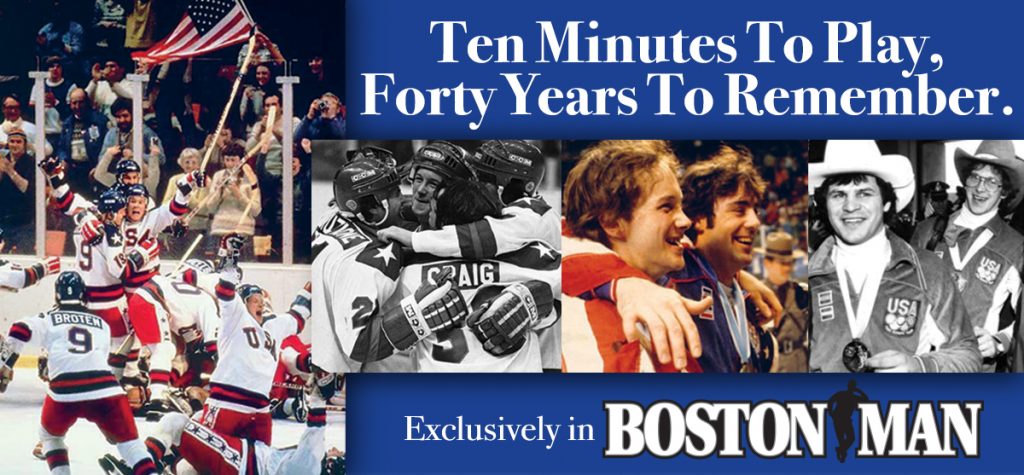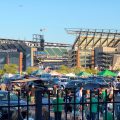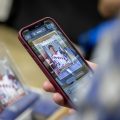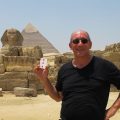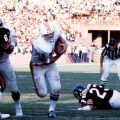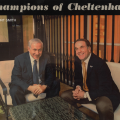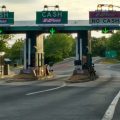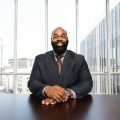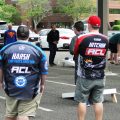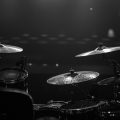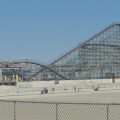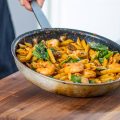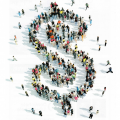Author Archives: kurt

The Miami Dolphins Perfect Season: Undefeated For 50 Years
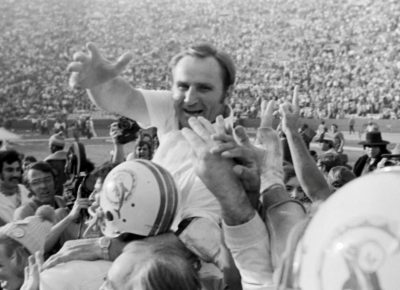
Half a century since the Perfect Season of 1972, no team has put all of the pieces together to match the feat. MiamiMan caught up with Larry Csonka and Manny Fernandez from that destined team, along with coach Don Shula’s son David, to celebrate the 50th anniversary of the achievement. (Here is the article as it appeared in the magazine.)
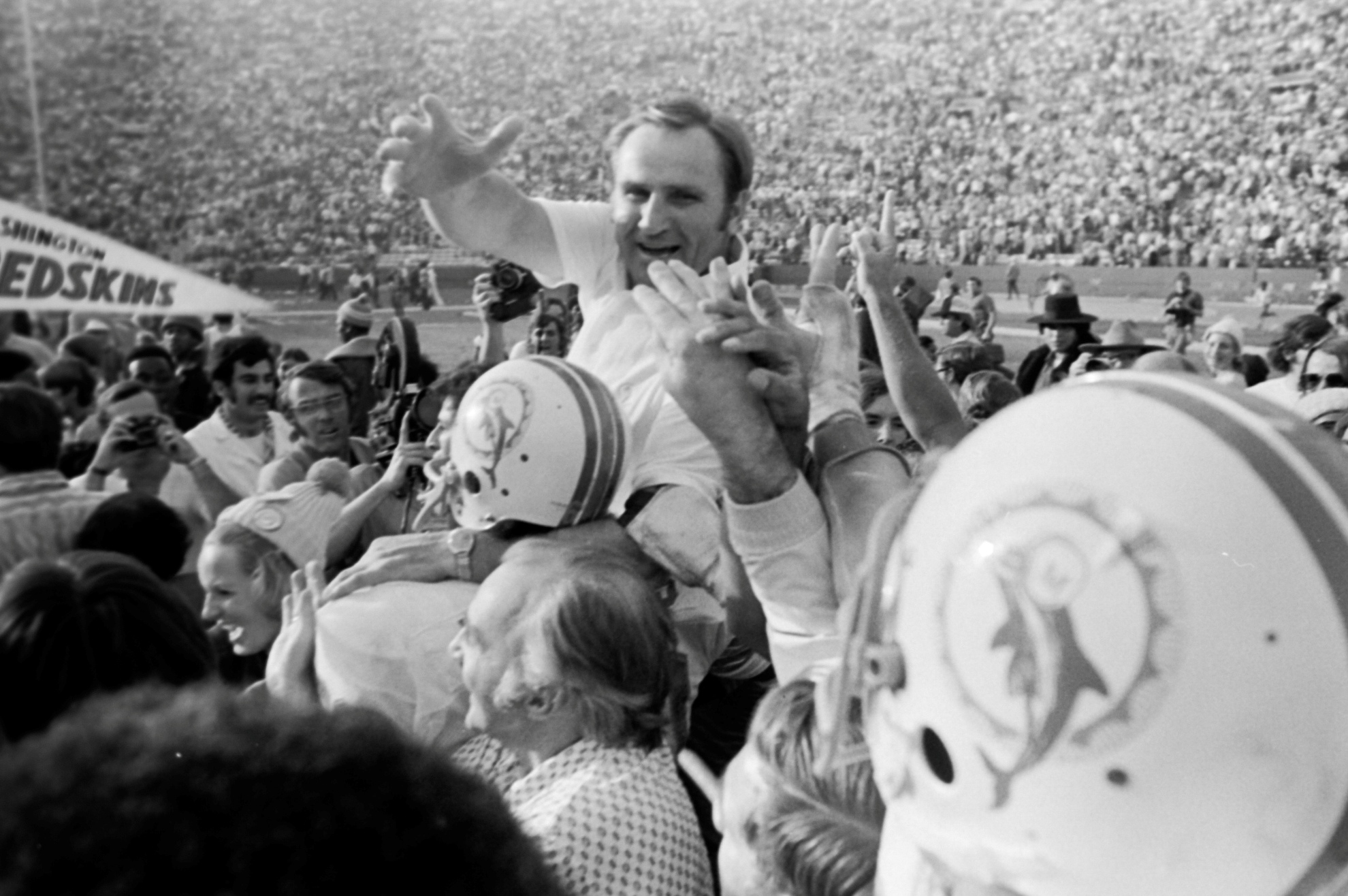
Everyone knew who the best coach was.
(Photo courtesy of the Miami Dolphins)
With the AFC Championship on the line, Larry Seiple defied the winningest coach in NFL history.
The punter for the 1972 Dolphins didn’t receive the signal to run a fake from his coach. He simply saw the hole the Pittsburgh Steelers left open…a hole his grandmother could have run through, he told reporters. Reacting in the moment, Seiple held the ball and ran 37 yards.
Seconds later, a touchdown pass from Earl Morrall to Larry Csonka tied the game. That touchdown turned out to be the difference. The Dolphins won by four points.
There might have been a very good reason Seiple’s coach didn’t signal for a fake. Seiple might not have seen a charging defender. He might have tripped on the play. A Steelers defender might have stripped the ball.
Had it not worked, Seiple is fond of saying, he probably would have walked home from Pittsburgh…because Don Shula wouldn’t have let him on the plane.
But because it worked, because Seiple followed his instinct, the Dolphins became AFC Champions. Because a special teams player thought independently in the heat of the moment, the Dolphins went to the Super Bowl to complete an undefeated season.
Because Larry Seiple stepped up in a clutch moment, the Miami Dolphins of 1972-73 have stood alone to this day as the only team in NFL history to have won every single game of a season.
One clutch play.
As Csonka says, that’s how finite it gets.
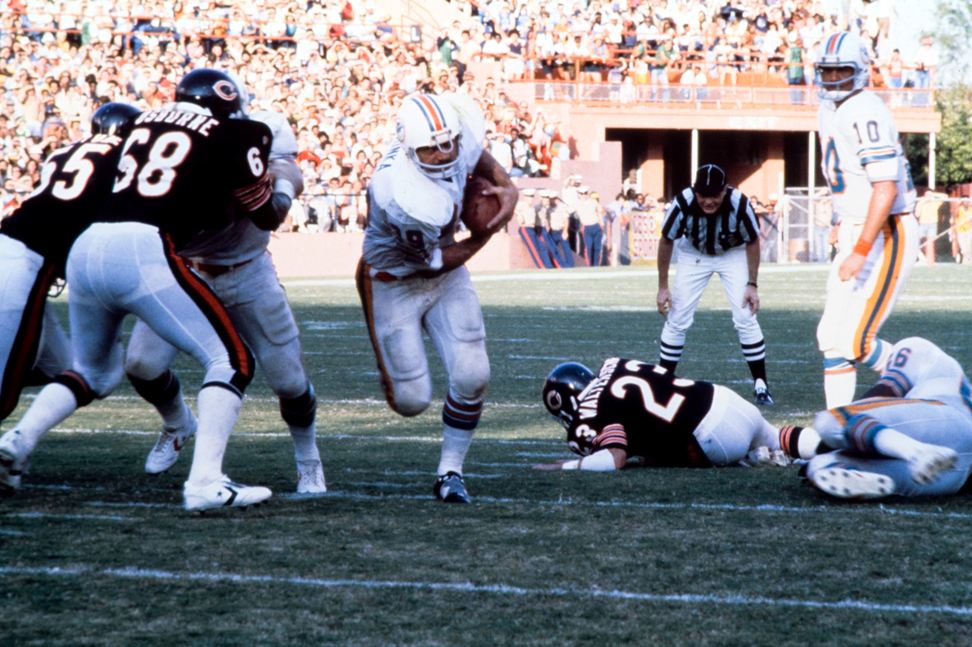
The Dolphins were always happy to give Zonk the ball.
(photo courtesy of the Miami Dolphins)
The point of highlighting Seiple’s moment of defiant intuition isn’t to suggest that a Perfect Season is a result of luck or even Divine Intervention…although a case could be made for a benevolent God smiling on a devout coach who attended Mass on a daily basis.
The point is to underscore the reality that to go an entire season undefeated, a team needs contributions from everyone, and a coach that relentlessly drills the importance of commitment and unity into them.
The 1972 Miami Dolphins weren’t lucky. They were a very, very good team…as any member of the team will be happy to tell you.
“Some people made a small contribution because he only got on the field at a certain time on one play,” Csonka remembers, “and other people made a larger contribution, but the fact of the matter is without all the contributions, you don’t have the Perfect Season.”
David Shula, son of the legendary coach, spent a great deal of time working in the team’s summer training camps as a young lad. He remembers what made their bond special.
“So many great people, not just great football players. You talk about guys like Bob Griese, and Nick Buoniconti, Larry Little, Larry Csonka, you know, Paul Warfield, Howard Twilley, Jake Scott, just tremendous human beings and great members of the community.
“They truly enjoyed being around each other,” he continues. “They wanted to win for each other more than they wanted to win for themselves, and really cared about each other and played for each other as a result.”
Manny Fernandez, one of the many stars of the absurdly nicknamed “No Name Defense”, also doesn’t see the Perfect Season as being luck or destiny.
“It was more everybody, every play, trying to do what they could. Those big plays that turned close games into victories, it was a different player every week coming through, whether it was a Dick Anderson interception or a Charlie Babb blocked punt or me stealing a handoff.
“And then, of course, we did have those games where we just beat them handily.”
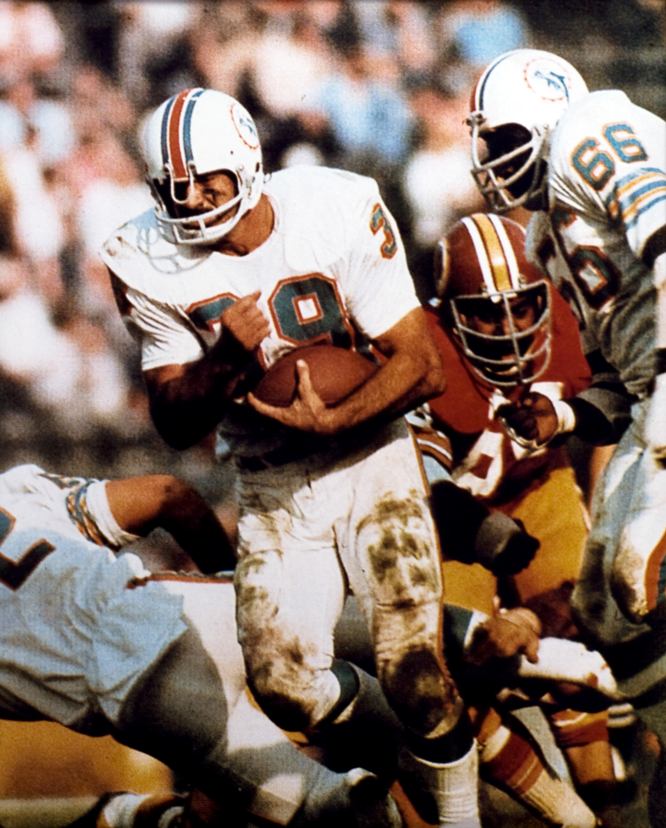
Running with one purpose…revenge.
(photo courtesy of the Miami Dolphins)
There was one key motivation that every Dolphin shared going into the 1972 season…a humiliating 24-3 loss to the Cowboys in the Super Bowl the year before.
Fernandez remembers it all too well.
“Losing the Super Bowl,” he still reflects with a sigh, “is the worst feeling in the world. You work so hard to get there. It’s hard to explain the disappointment.
“I bought 100 tickets for that game for family and friends. A lot of them were at the hotel we were staying at, waiting for us to come back. I had to take a break in the parking lot, just literally sat on the bumper of a car and let the emotions run. I was in tears, I had to compose myself before I could go in and face everybody. I just felt like I’d let my whole family and all my friends down, not to mention the fans in Miami.
“I think to a man we vowed, we weren’t gonna feel that way again next year. No matter how hard Shula pushed us or how hard he worked us, we knew why, we knew where we needed to be, and what we needed to do to get back and redeem ourselves.
“That whole season was redemption.”
Csonka remembers that Coach Shula was emphatic that every game in 1972 was going to be treated like the Super Bowl.
“Had he anticipated that we were going undefeated? No, I don’t think he had any design on that. Just how serious we were going to approach every game, so that by the time we got to the Super Bowl, if in fact we did, we would be ready and know how to prepare. And that part was a prediction and that part did come true.”
The coach, Zonk and Manny both remember, used every edge on the field…including Miami weather.
“He decided that we would practice twice to sometimes four times a day in 90 degree heat,” Csonka recalls, “and we would become camel-like so that we were acclimated to that tropical situation. Any kind of little idiosyncrasies like that, he used those as added gunfire in the battle.”
Fernandez wasn’t always a fan of playing in the intense Miami heat, though.
“You get on that poly turf, and the temperature of the surface would be 120 degrees, and the air you’re breathing is 110. There’s no doubt it gave us an edge, but it also cut into us a little bit as well. There were more times than one I was getting intravenous fluids at halftime to keep from collapsing. It wasn’t always fun with that hot weather.”
Coach Shula demanded a lot, Fernandez says, but “the guys on the team, we respected him and what he was doing, and what it was doing for us.”
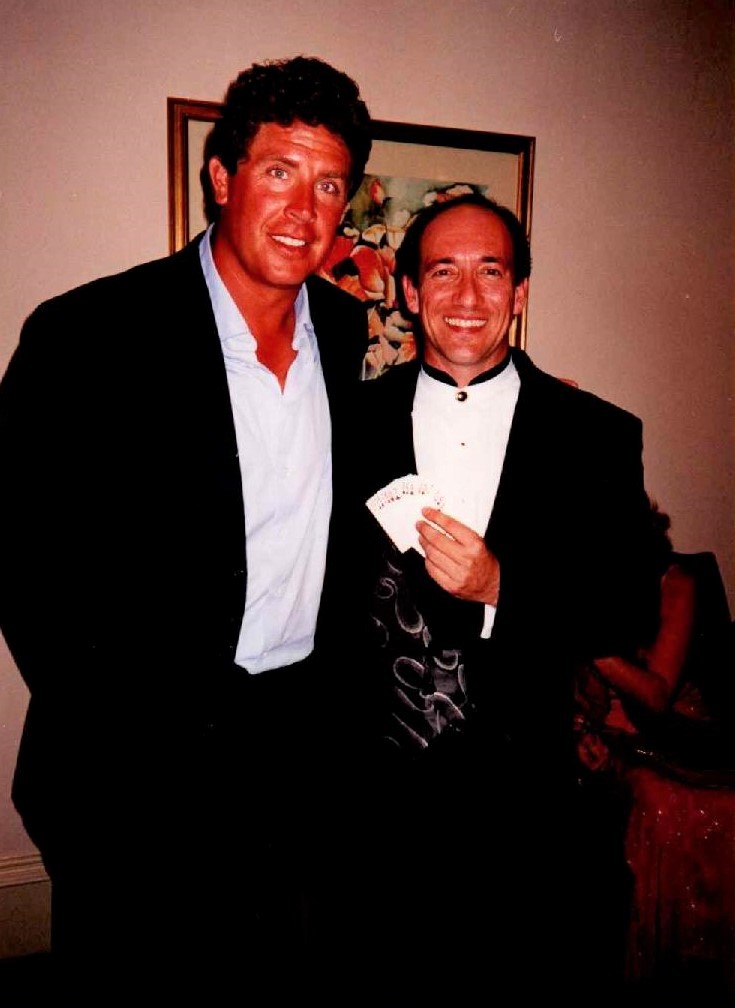
Dan Marino worked his magic to ensure the Dolphins stand alone.
(photo courtesy of Mio Rodriguez)
Perfection, by definition, is impossible to attain for humans. To claim that any achievement is perfect, we have to redefine the meaning of it.
The Miami Dolphins of the 1972-73 season didn’t shut out all of their opponents. Larry Csonka and Mercury Morris didn’t make it to the end zone every time they carried the football. Bob Griese and Earl Morrall didn’t complete every pass they threw. Garo Yepremian’s inexplicable Super Bowl gaffe nearly negated the unprecedented achievements of an entire season.
But within the parameters of a Perfect Season, the Miami Dolphins have set the standard. Seventeen football games, every single one of them ending with a Dolphins victory. The team was as perfect as it needed to be to be called the greatest team in NFL history. Half a century later, no team has been able to meet even that scaled down definition of Perfect.
Two teams have come very close…the 1985 Bears and the 2007 Patriots.
Dan Marino and the Dolphins did their part in turning the 1985 Bears’ campaign into an Almost Perfect Season. Dave Shula was coaching under his father that Monday night at the Orange Bowl. He remembers how electric the atmosphere was, and the strategy they devised to beat a seemingly unbeatable team.
“We had a revolutionary plan that nobody else had tried, and we said, what the hell? Nothing else has worked. Because they were just overpowering people.
“The simple plan was just to put him in the game, Nat Moore, instead of a tight end on first down, and throw the ball. They didn’t substitute and they tried to cover him with Wilbur Marshall, who couldn’t cover Nat Moore. And we put up a big number on them by halftime.
“That was one of the all-time great teams,” Shula remembers with pride, “but they will never be able to say they had the perfect team.”
Of the 2007 Patriots’ campaign that ended with the season’s only loss, Larry Csonka says that he is still the “biggest fan” of Giants head coach Tom Coughlin and quarterback Eli Manning. Even as the unbeaten Patriots were 12-point favorites over the 10-6 Giants in Super Bowl XLII, Mercury Morris could still be seen on TV reminding everyone that “to be undefeated, you got to win every game!”
Manny Fernandez knows better than anyone how the Patriots’ season revived the memories of the Dolphins’ perfect campaign.
“I was actually watching the game with the reporter from the Palm Beach Post. He had come to the house with a cameraman and a sound person, and he was talking to me all through the game and literally putting it on air. Then when the game was over, the local channel that did the Don Shula Show, they sent a crew over to the house at 11 o’clock at night to interview me!”
Dave Shula remembers that his 78-year-old, ultra-competitive to the end father was at the game, and “I remember him saying that he jumped up, and had the smallest measurable vertical jump in the history of vertical jumps.”
Dave worked at Shula’s restaurants for 22 years, and following the improbable Giants victory, “we sent Eli Manning a bunch of gift certificates for he and his offensive linemen to share with their teammates to Shula’s.”
“We’re proud of being the only undefeated team in history,” Fernandez reflects.
“We worked hard to do it.”

Because 50 years ago, a group of guys made Miami a football city.
(photo courtesy of the Miami Dolphins)
It’s impossible to measure what the success of a sports team does for a city, but the 1972 Dolphins gave the Miami community a new point of pride…and it still does today.
Dave Shula remembers his family leaving for Miami from Baltimore when his father was hired away from the Colts. “My classmates had put little paper signs and they hung them in the windows all the way across the classroom that said, basically, ‘Dolphins suck.’”
But the winning coach was most welcome in an area where the only major sports team in the city had only won three games the season before.
“Miami even then being such a melting pot,” his son remembers, “there was nothing that really pulled the people together from the sports scene until the Dolphins in ’70. They started to win, and then continued that in ’71 going to the Super Bowl, and then of course the undefeated season. It really galvanized the community. I remember going to those games as a little guy, how exciting it was going to the Orange Bowl. They were constantly sold out and the fans were just terrific.
“I like to joke that I had a lot of new best friends on Monday morning. I remember a picture that was in the Miami Herald after they won the Super Bowl. There was a whole bunch of people from my school in the background. I think I only recognized one of them, and they were all hugging me like I was their brother. It was funny.”
Csonka remembers a diverse number of age groups in Miami as well as nationalities, who suddenly had a common bond.
“The older ones were enthusiastic fans,” he recalls, “whether they moved down from Buffalo or New England or wherever they moved down from to retire. The young ones, of course, are fired up to be first time champions.
“Those two sections of fans came together as a very, very enthusiastic crowd. If you go back and look in the early 70s when Shula first came, sales and season tickets went up terrifically, and we had sold out situations in the early part of the season in 1970.”
Is Miami represented in all four major sports today without the early 1970s Dolphins proving that the city will very enthusiastically support a winning team?
That’s impossible to answer, but the Rays’ attendance numbers don’t exactly make a strong case to add an NBA team in Tampa Bay. And they were in the World Series not long ago.

Never in American professional football history.
Manny Fernandez reminded this scribe that it isn’t just the 50 years since that hasn’t produced an unbeaten and untied team. It hasn’t been done by any other team in the 103-year history of the NFL, even when seasons were only eight games long.
Yes, the Dolphins caught some breaks and won games that turned on a single play. And Dan Marino and Eli Manning both played a vital role in keeping the most astounding team achievement in NFL history unmatched in 50 years and counting. Every team that climbs the highest of mountains benefits from some luck.
But in the grand scheme of things, what made the Perfect Season possible was a team full of outstanding players, a brilliant and uncompromising coach, and a truly unified dedication to victory on the part of everyone involved…right down to a punter who was willing to go against his coach and be willing to walk 1,181 miles if it went bad.
A Perfect Season doesn’t turn on one big play. It’s the sum of all of its parts, every player, every play.
As the Miami Dolphins of 1972-73 all know, it’s better to be good than lucky.
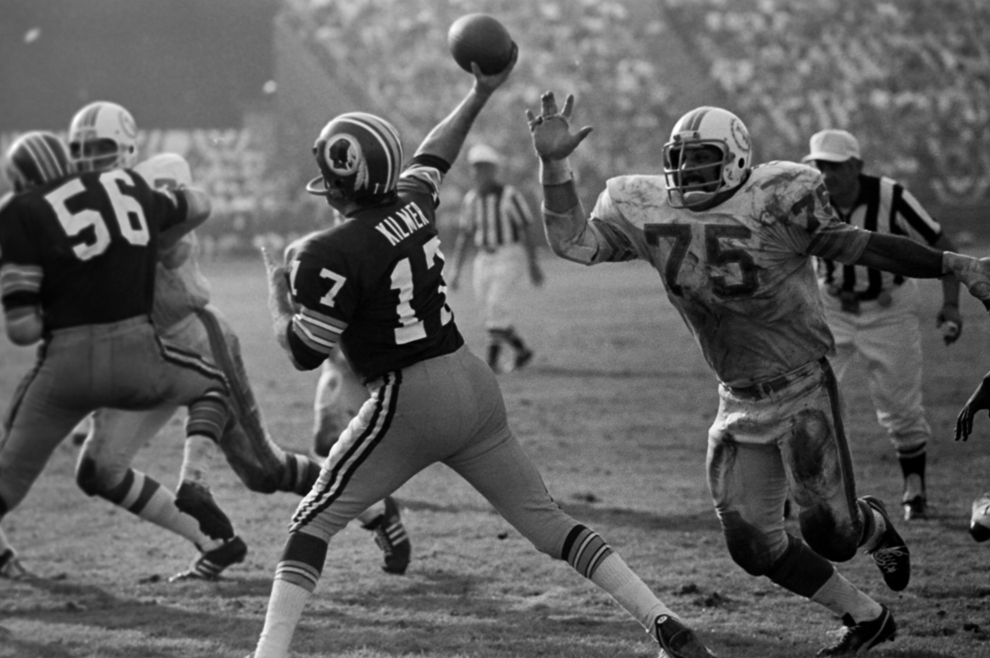
It was never long before Manny was on you.
(photo courtesy of the Miami Dolphins)
Manny Being Manny
Cowboys coach Tom Landry is often credited with the “No Name Defense” appellation given to the 1972 Dolphins defense…a squad that featured Nick Buoniconti, Manny Fernandez, Bill Stanfill, Jake Scott and several others. They led the NFL in fewest points allowed in 1972, and also held Billy Kilmer and the Redskins offense scoreless in the Super Bowl. (Washington’s only touchdown came on a special teams play, famously known as “Garo’s Gaffe”.)
In that game, Manny Fernandez made quite the name for himself, with 11 tackles, six assists and a sack…but the Super Bowl MVP award would go to Jake Scott. Csonka and Buoniconti took issue with the award, believing Scott and Fernandez should have both gotten game balls.
But when asked about the snub, Fernandez says with a chuckle, “We won, didn’t we?”
“I was there to win the game, not get a trophy.”
It turns out he didn’t remember a lot about the end of the game, even at the time. He doesn’t tell the story often, but Manny sustained a head injury late in the game.
“I received a concussion right about either the end of the third quarter or the beginning of the fourth quarter. It was a swing pass to Larry Brown. I made the tackle, got him by the jersey, swung him around, and as we swung down to the ground, Nick came in to finish him off and got me right in the temple.
“I played out the game, but I don’t remember any of it. I don’t remember that night, the celebration. Woke up in the morning, I had to ask my wife if we won.”
It’s easy to call Fernandez a big game player…his Super Bowl totals include three sacks and 28 tackles in three appearances on football’s biggest stage. But as Dolphins fans knew, those types of performances were just Manny being Manny.
Fernandez recorded 35 sacks in his eight year career, with 4 1/2 sacks in the postseason. He was a second team All-Pro twice, a second team All-AFC selection twice, and an All-AFC selection once. The Dolphins wouldn’t likely have won back to back Super Bowls without Manny Fernandez pummeling offensive linemen…and his desire made him a perfect fit for Don Shula’s design of a championship team.
“I came into Miami as an undrafted free agent, more or less an afterthought. The entire first week, I did not practice one play. Did all the warmups, did all the work on the machines, the tackling dummies, did all the dummy stuff. I never got on the field until Friday morning.
“Jim Urbanek, number one draft pick, defensive tackle, blew his knee. They put in another number five draft pick from Alabama, and he blew his knee. Coach (Les) Bingaman, our defensive line coach, came over and said, any of you think you can play this game?
“I just looked at him, I said, you’re g**damn right if you give me a chance. He said, okay, Mexican, see what you can do. I went into that scrimmage, bound and determined that I was going to make a name for myself. I was going to make that football team. And I did.
“I started every game from then on.”

Three true team players.
(photo courtesy of the Miami Dolphins)
The Interchangeable Backfield
There are many stories of members of this team being willing to sacrifice their own personal achievements for the team, but the best example is easily Jim Kiick and Mercury Morris, who split running back duties throughout the season…Kiick as more of a blocking back for Csonka, and Morris as more of a runner who could get to the outside fast.
The younger Shula cites his father’s handling of the Kiick and Morris situation as an example of how the coach set the tone of playing for the team first.
“The story goes that either Jim or Mercury would be in my Dad’s office on Monday, and it was the one that didn’t get to play much the day before. He knew that they needed to vent their frustration because of their competitiveness.
Dave Shula speaks not just as Don Shula’s son, but as a former NFL coach himself. “It’s hard to do that, to keep your star players that aren’t getting the ball as much as they think they should, to keep them content and keep them working toward the goal of helping the team win.”
Csonka remembers the camaraderie between Kiick and Morris, even as the few shared the spotlight in the Miami backfield.
“You’d see Jim run off the field, Merc would be running on, and they’d smack hands as they passed each other. Jim only ever bitched one time. We were close to our own end zone, and it was a 40-yard sprint with the bench, and he didn’t like that part. He didn’t want to run 40 yards to the bench and 40 yards back!”
Csonka remembers the moment with a laugh, but as a Hall of Famer who played for winning and losing teams in his career, he knows how it could have turned out had Kiick or Morris not been on board.
“If you don’t have that,” Zonk says of the two players’ mutual respect, “if you have animosity that builds, it’s like a cancer on the team. It’ll start between two players, and it’ll carve up the team before it’s over.
“But Shula made such a strong case of everyone being disciplined to the fact that winning became more important than personalities or number of carries or any of those other things.”

“Get ready to shed your placeholder status, Earl.”
(photo courtesy of the Miami Dolphins)
“Weak Schedule” vs. “Backup Quarterback”
It’s been noted by sportswriters and non-Dolphins fans that the 1972 Dolphins benefited from a weak schedule, and the claim isn’t entirely without merit…only two of the teams the Dolphins defeated during the season had winning records.
But if someone brings that argument up with you, remind them that the Dolphins also lost their Hall of Fame quarterback in the fifth game of the season, and proceeded to win nine games and a playoff game with a backup quarterback. It’s doubtful the 2007 Patriots could have pulled that one off.
Backup QB Earl Morrall is one of the 1972 Dolphins’ biggest heroes. Following Bob Griese’s ankle injury, Morrall took over and kept the train rolling. He threw for 1,360 yards and 11 touchdowns in nine games, and then led the team to a victory in the Divisional Round playoff game against the Browns.
But most importantly, after bringing the Dolphins to the dance, in the AFC Championship game Morrall went back to the bench and let Griese finish the job without complaining. Like everyone else on the team, he had made his vital contribution to the Perfect Season.
In his book, The Winning Edge, Don Shula tells the story of convincing Dolphins owner Joe Robbie to pick up Morrall to back up Griese. Morrall had been the backup for Johnny Unitas and had performed a similar feat in Baltimore, leading the Colts…coached by Shula…to a Super Bowl as a backup before their infamous loss to the Jets in Super Bowl III.
The Dolphins, being the AFC champions at the time, had the second to last chance to claim Morrall when the Colts placed him on waivers, but the rest of the NFL passed on a backup QB who would make history starting and winning nine games of a Perfect Season.
Shula recalled the moment when he decided to switch back to Griese to start the second half of the AFC Championship game against the Steelers.
“What I had to tell him was hard. He had done the job all season long and I was appreciative beyond words. But I had to do what was best for the team.”
In the brief conversation they had, Morrall immediately accepted the decision and informed Shula, “If you need me I’ll be ready.”
If anyone exemplifies what it takes for a team to achieve a Perfect Season, it’s Earl Morrall. Who was Tom Brady’s backup in 2007 again?

Eagles Tailgating: The Greatest Party in Greater Philadelphia
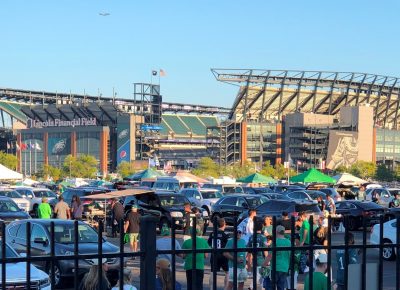
There is no gathering anywhere in the region like an Eagles tailgate. (Published for the Fall 2023 issue of PhillyMan…see the magazine article here.)

Most of the thousands clad in green at the party on Pattison probably don’t even realize it, but there is a truly special element to being in the parking lot on Eagles game day.
It’s that no matter your political persuasion, your religious denomination, your ancestral roots or your musical taste, you have something in common with the stranger next to you. In the parking lots surrounding Lincoln Financial Field on game day, everyone bleeds green and shows their commitment. On Game Day, the Birds are the only thing that matters to anyone.
Tailgating, at first glance, seems an alternative to paying the eternally brazen “atmosphere fee” for food and libations inside a sports venue. But when the party encompasses more than a square mile and looks like this, its purpose goes well beyond thrift. To call an Eagles tailgate a party, to even call it a celebration, is a rank understatement.
Throughout the lots at the home of the Eagles, including those meant for other teams who happen to play here, you can walk in any direction and see buses, campers, trucks and vans…the majority of them covered with artwork that would provoke a double take on the highway. It gives one pause to consider how much of a fan one must be to shell out the kind of coin needed to decorate a vehicle so magnificently.

After a long day of painting a bus, it’s time for a drink.
Everywhere in this mammoth block party, one hears loud music from a variety of styles and eras. Everywhere, you can smell coal, sausages, burgers, and yes, frequent whiffs of reefer. And anywhere you happen to be, you won’t often go five minutes without hearing an Eagles cheer…usually begun by one person, which easily gets at least a dozen more to join in.
If you’ve never been a part of tailgating at this level, you’ll be truly amazed at the dedication of a large number of participants. The seasoned pros arrive early…as much as six to eight hours before game time. (Do the math of how early you’d have to get out of bed, on a cold November Sunday morning, to tailgate for a 1:00 game.)
Veterans of Eagles tailgating even have their designated parking spots, that they head directly to when the gates open…for various reasons, such as being near a grate that can be used as a bathroom. True.
You can easily spot the amateurs…the late arrivals. They spend far too much time in an agonizingly slow quest…not only to find an open spot, but to work their way into it as carefully as possible to avoid gazebos, coolers, and equipment that other tailgaters have established hours before.
Hopefully they’ve learned their lesson from the experience…you need to take this party a heretofore unheard of other level of seriously.
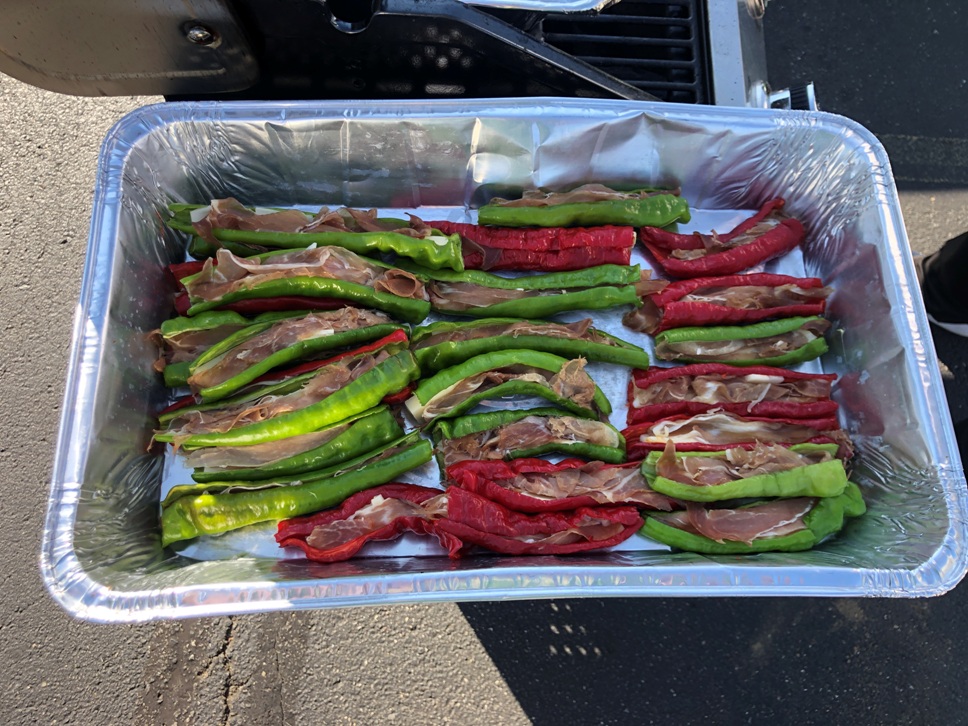
Dan Kukral’s stuffed long hots are reason enough to be part of the Danny Burke tailgate on game day.
Dan Kukral is the head chef of the Danny Burke tailgate, named for his brother-in-law who runs much of the party. He was given the chef’s role, he says, because “I come up with all the fun ideas for food.”
Kukral is a research scientist at a pharmaceutical company, which is remarkable given what you’re about to read about his contribution to game day.
He and Burke usually begin the party preparation about five to six days before game day (yes, you read that right). Once they’ve gathered food and supplies for a party that can be for as many as 200-300 people and brought it all to the Linc, he takes on the sizable cooking duties.
Needless to say, it’s a lot for one guy. Kukral simultaneously looks after the preparation of ribs, pulled pork, shrimp and sausage bayou, Buffalo chicken dip, and of course, dogs, burgers, wings, sausages with peppers and onions…even long hots with stuffed provolone and prosciutto. As anyone can easily see from the hefty, mouth-watering piles of grub, he’s more than up to the challenge.
It’s all a labor of love, he says. No kidding…a system as efficient as this doesn’t happen casually. The Danny Burke folks get contributions from participants, which covers the food and drink, but he doesn’t get paid for his more than considerable efforts.
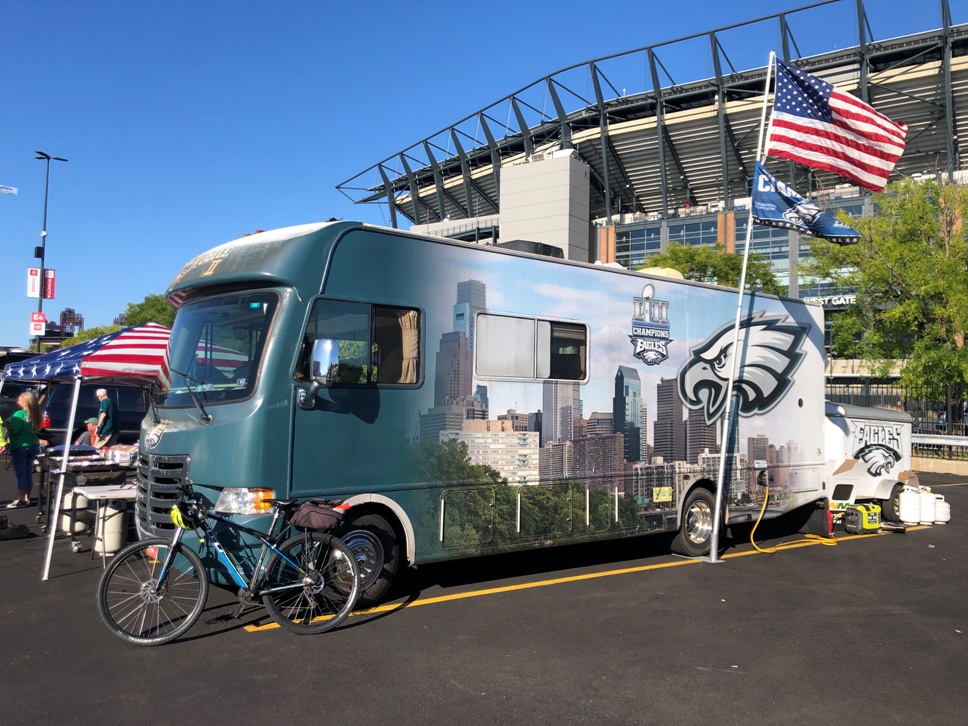
If you think this pain job is impressive, check out the back.
Kukral is just one of many for whom Eagles fandom is a passion worth the investment of time and money.
This observer also spoke with Ed Callahan, whose camper has occupied a spot in the Wells Fargo Center lot since the opening of Lincoln Financial Field. Ed tells an amusing story of why he and his crew acquired a camper.
“In 2004,” he recalls, “I went to a road trip game in Cleveland. There were four of us, and we parked in the lot next to a beat-up old RV. For a swap of a cheesesteak, the guy who owned the RV let us use the bathroom.”
An even trade, certainly. But bringing a bathroom to a tailgate, they realized, was a super idea, for obvious reasons.

“I’ll knock the loyalty to Kathie Lee right out of you!!”
Ed and his crew bought an old RV, fixed it up, and made it a staple of the parking lot. They eventually had to replace it following a wreck, so they’ve upgraded to a new one.
Callahan’s current camper is a thing of beauty to behold for a Philadelphia football fan, and it might be the most artfully decorated vehicle at the Eagles tailgate…which is undeniably saying something. The back of the RV is adorned with a large scale timeless image of Frank Gifford lying motionless on the field, following the epic Chuck Bednarik hit. On the side is a wide panorama skyline shot of our city, ranging from 30th Street Station to Billy Penn’s statue.
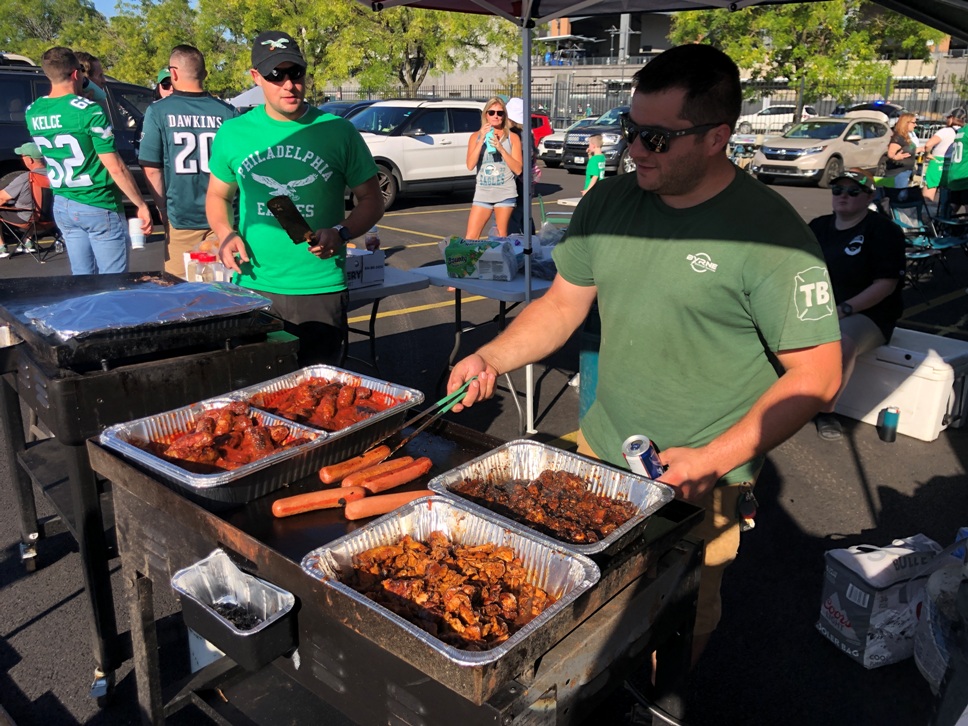
Anthony is the right man for the job.
The cook of Callahan’s crew is a gentleman named Anthony. Anthony is definitely keeping busy looking after sausages and other comestibles. He estimates that their party serves anywhere from 30-100 fans each home game.
Executing a successful tailgate, Anthony says, is a full-time job. “All week, getting food together, cleaning the RV, getting all the grills, utensils, tables, and all that. It’s a full day…breakfast, lunch and dinner in the parking lot.”
Ed says their breakfast specialty is an Irish American Philly Omelet… made with imported Kerrygold cheese from Ireland, Cooper brand American cheese, and Philadelphia cream cheese, all in a three egg concoction.
There might be a few NFL cities that are in Philadelphia’s universe when it comes to the magnitude of the pre-game party. But there is one thing that The City of Brotherly Love offers that is unique: cheesesteaks, scrapple and pork roll.
Buffalo can keep their wings, December weather, and four straight Bowl defeats.

These people need a lot of stuff.
To witness football fan dedication of this level brings to mind a whole world of entrepreneurial opportunities for local businesses. Incidentally, our friends at Duck Donuts realized this…on the day this article was written, the author received an email with a subject line that read: “Win The Tailgate With Donuts!” They get it.
Sure, for liquor stores, sandwich shops and food markets in the area, it’s obvious. Put it in your promotional materials that you offer everything Eagles fans need for Game Day…cases of beer, large bottles of liquor and mixers. Ready-made subs and pizzas, bulk packages of burgers, sausages, chips, dips, and rolls.
But that’s just scratching the surface. A party this size needs it all.

“Say, who painted your RV?”
An owner of an RV dealership can add a bar and lounge to the inside of a used camper to make a sale to a dedicated Eagles supporter. Vehicle wrapping and decorating outfits could market their wares to fanatics that buy multiple spots at considerable cost for their RV.
Needless to say, anyone selling Eagles gear could market to the block party…most all of whom represent their team faithfully with jerseys, caps, face paint or any kind of accessories featuring the Eagles logo and colors.
Outdoor stores could make a serious profit too. Grills, propane tanks, coolers, generators, portable toilets, anything associated with RV adventures might be applicable to a tailgating demographic. Space heaters and fuel would undoubtedly be in big demand in the colder months. Decorating anything with the Eagles colors and logo could make the sale to the typical Linc lot enthusiast.

This band was playing Van Halen’s “Unchained”, and the guitar player handled himself quite well. It’s no place for amateurs.
It’s even an opportunity for catering services, private event coordinators, DJs, even live musicians, all of which you can easily find at an Eagles tailgate.
If nothing else, fly a plane towing a banner over it all for the thousands in the lot to see…which also happens frequently.
You get the idea, but even if you’re a realtor or a financial advisor, there’s no reason why you can’t build goodwill by renting a camper, hosting a game day party and inviting your customers, as one business owner (who asked for her name not to be shared) does.
No doubt, your Eagles fan patrons will speak well of you.
Because after all, you’re family.

As seen on the movie screen!
As Seen In The Movies: The Silver Linings Playbook Eagles Bus
If you’ve ever seen the movie Silver Linings Playbook…and if you’re a Philadelphian, you should…you likely remember the scene where the Eagles-decorated “Asian Invasion” bus shows up in the Linc’s parking lot on game day.
In the scene, protagonist Pat Solitano Jr., has just been released from a mental health facility for bipolar disorder. At the game, he notices that his therapist, Dr. Cliff Patel, has emerged from the bus.
He catches up with Patel…whose face is painted green and silver…and Patel dispels any concerns about their meeting outside of the facility: “Today, I’m your brother in green, not your therapist.” Soon, the two have a discussion with Pat’s friend about what the Eagles strategy for the game should be, punctuated with hilarious foul language.
After the movie was made, no one really knew what to do with the bus, and so a movie hand decided to sell it on Craigslist.
Bill Curley, a long, long time veteran of Eagles tailgates, went for it, and today the Asian Invasion bus is parked in the Wells Fargo lot for every Eagles home game.
“One of the people working on the movie ended up with the bus, and nobody wanted it,” Curley remembers. “The Inquirer wrote an article about how the bus was for sale prior to the Super Bowl. Once they won it, I called the guy on the phone and said, ‘hey is the bus for sale?’ and he said yes.”

The author of A Great Number of Things enjoys some time in the Asian Invasion bus.
Curley bought the bus for $9,000 in 2017. He estimates that he’s put a total of $30,000 into the investment. The bus is comfortably remodeled inside, with cushioned benches and Eagles decorated chairs, offering a spot to escape weather that can be trying in this part of the world any time of year.
“I come here early and park right here at the end, so people can take pictures. It attracts people from all over the country, I’ve had several people from Canada. A lot of ‘this is my first game, I’m from Utah, it was a birthday gift,’ they come and introduce themselves. It’s a neat thing.”
He still gets into the party, showing up early, saving spots for family and friends, and cooking sausage and peppers for whoever shows up. He was at the Linc at 11:30 AM for the Thursday evening home opener. “It starts early and it ends late,” he laughs. “My daughter’s coming today with her friends.
“This isn’t the most comfortable thing to drive in traffic, so I leave early.”
If you’d like to see the movie scene, you can search for “Silver Lining Playbook Eagles Tailgate Scene” on YouTube. And the next time you’re at an Eagles home game, check out the Asian Invasion bus…it’s well worth a look.
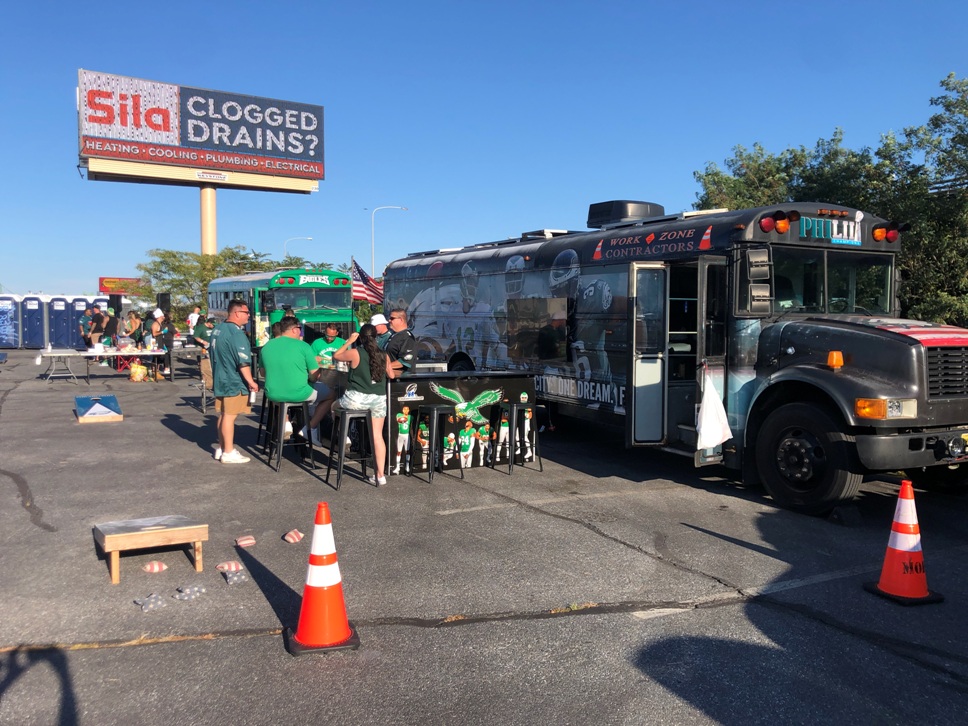
They mean it in the Jetro lot.
The Jetro Lot
While the Eagles tailgating scene is a thing to behold throughout all of the parking lots, some lots are at a different level of enthusiasm than others, and the parking lots at the Jetro Warehouse east of the Linc are undoubtedly the wildest.
To Philadelphians, the name “Jetro” is probably more known for what takes place in their parking lots than for what they do…they are a wholesale restaurant supplier, selling catering supplies and food preparation equipment to caterers and restaurant owners throughout the region.
But it’s likely that their most important…and maybe profitable…contribution to the city is their ample amount of parking spaces in the Sports Complex. The Jetro folks are, needless to say, aware of this, and they even have Facebook and Twitter pages dedicated expressly to their parking offerings for Philly sports events.
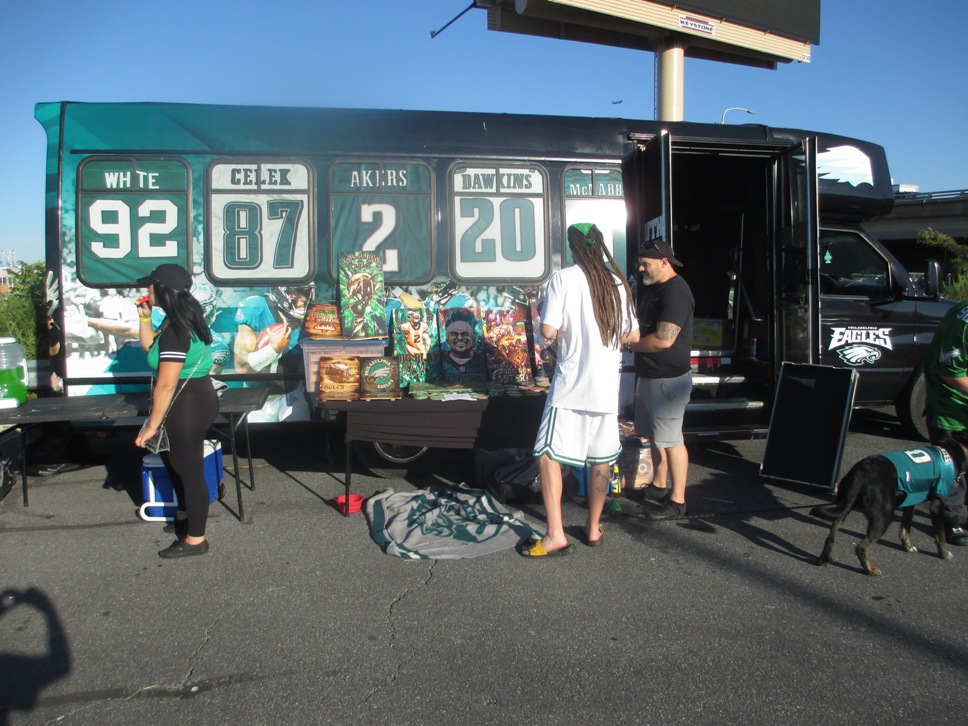
The art stylings of Jonathan Metz.
The most serious of Philly tailgaters seem to congregate at Jetro. In this observer’s visit, just a small sampling of things to see were a large number of beautifully decorated buses, a gentleman by the name of Jonathan Metz selling superbly Eagles-themed woodworks, coasters and other items, and a live band whose guitar player could mimic Eddie Van Halen’s licks quite well. That’s a ridiculously small sample, but magazines have space limits.
Jetro’s lot isn’t a place where you’d want to bring the kids or your church group. It’s loud and raucous, with music that often features lyrics full of f-bombs. There’s also a few flags that are openly critical of the current occupant of the White House, and not in a polite way.
But if you can handle that, and you truly want to show your Eagles fan dedication, the Jetro lot is likely the destination for you. It’s well worth a visit, if only just to see the level of fandom the local football team inspires.

Ten Minutes to Play, Forty Years to Remember

My article celebrating the 40th anniversary of the Miracle On Ice was originally published in the Winter 2020 issue of BostonMan Magazine. Click here to see a PDF of the article, or click here to see the article on BostonMan’s website. I’m very proud of this one, hope you enjoy it.
Ten Minutes to Play, Forty Years to Remember
February 22 marks the 40th Anniversary of the Miracle On Ice, still today regarded among the greatest, if not the greatest moment in sports history. BostonMan caught up with three key players from Team USA…Boston University alumni Jim Craig, Jack O’Callahan, and Mike Eruzione…to talk about the achievement and its aftermath.
The puck rose off Mike Eruzione’s stick and soared past Vladimir Myshkin’s outstretched pad. An arena full of 8,500 fans, along with a newly inspired nation, erupted.
For the first time, in this game and against this team, the U.S.A. was ahead. With exactly 10:00 on the clock.
Ten minutes. Against a team capable of six goals in that kind of hockey eternity.
The players wearing red, for maybe the first time in their lives, were rattled. They missed shots. They missed passes. They missed opportunities.
But this was still the Soviet Union team, arguably the greatest hockey team ever assembled. This team didn’t often go half a period without putting a puck in the net. The score, and the momentum, could change on a dime.
And they had ten whole minutes to correct this aberration, this trailing of a nation that wasn’t known for producing world class hockey players.
Forward Rob McClanahan, in his diary later published in Goal magazine, would call it the longest ten minutes of his life.
“We’re like, oh my God, that’s a long time against these guys,” defenseman Jack O’Callahan remembers.
Ten minutes from immortality. Survive these ten minutes, and you will someday be symbolically credited with taking down an Empire, armed only with a hockey stick.
Hold off the Reds for ten minutes, and forty years from now, the eyes of strangers from sea to shining sea will still tear up in emotion when they meet you.
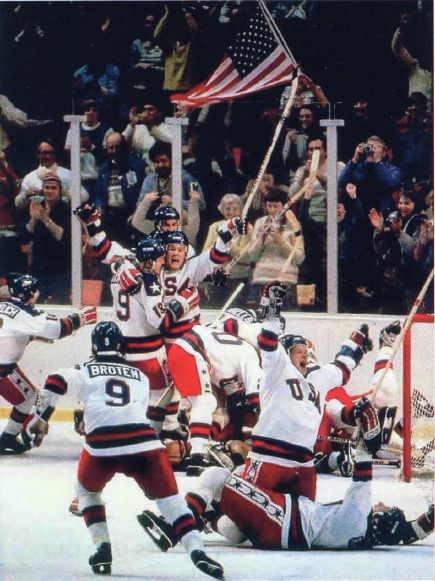
Celebrating a Miracle.
Unlike everyone else on Planet Earth, Herb Brooks was not shocked.
He built this team for this moment. He expected them to be here. From behind the bench, he brought a wave of calm to a heart-stopping situation, repeating three simple words:
Play. Your. Game.
Do what got you here. This is no fluke. You’re ahead in this game for a reason.
Indeed, as O’Callahan, goaltender Jim Craig, and team captain Mike Eruzione can tell you, they spent months preparing…mentally, emotionally and physically…to play ten third period minutes of inspired, fearless hockey against the greatest team in the world.
“Most teams,” Craig reflects, “once they got ahead of the Russians, did a prevent defense type thing. And the Russians crushed it all the time. But we didn’t. My strategy at that time was, don’t tie the puck up, don’t give them a chance to regroup, keep it going.”
Eruzione agrees. “In the last ten minutes, the Soviets had I think, seven or six shots on goal and three of them were from outside the blue line. As Robbie said, it was a long ten minutes, but boy, we played really well in those ten minutes.
“We had great team speed, great conditioning, our conditioning was off the charts. And you get solid goaltending like we had from Jimmy, and now you’re in every game that you can play.”
“We won every third period,” Craig correctly recalls.
This was no aberration. These boys really were exceptional hockey players, who paid their dues through months of backbreaking training, under a single-minded coach.
“The bar was so high, you had to do everything you could just to stay close to the bar,” O’Callahan remembers, “and every time you get close to the bar, Herbie would raise the damn thing.”
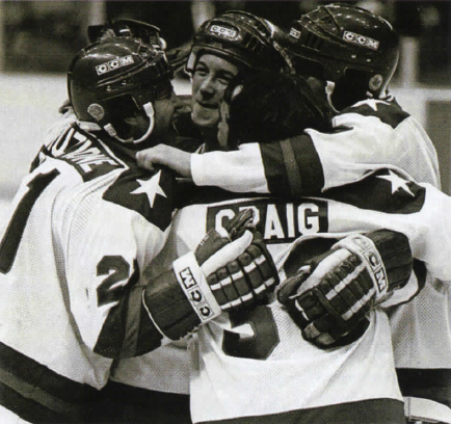
O’Callahan, Craig and gold medal teammates.
Not everything in Disney’s outstanding Miracle film is completely accurate, although the players will tell you it’s generally on point.
One deviation from reality is its much more sympathetic portrait of a coach who was about as sentimental as a kick in the groin. O’Callahan remembers a teammate (Phil Verchota, he believes) saying, “Boy, they really softened Herb up for the movie.”
“Yeah, he was a lot friendlier in the movie,” Eruzione agrees. “Herb didn’t care if you liked him, and there were a lot of times we didn’t like him. But it was important that we respected him, and there never was once a time when we didn’t respect him. Here’s the option, you deal with it or you quit.”
Like his teammates, Eruzione lived in perpetual fear of being kicked off the Olympic team. It was, they agree, one of Brooks’s favorite motivational tools.
O’Callahan says that “even Mark Johnson, who was our best player, leading scorer…Mark would probably tell you that even he wasn’t sure. Herb was like, if you don’t want to work hard at this and you don’t think you need it, fine. I got 200 other guys that want your spot on this team.”
Craig says the movie conversation where Brooks informs him that he’ll be replaced with Steve Janaszak didn’t happen, but it could have.
“It made sense, because if that was a way to motivate someone, Herb would do it.”
Through intense psychology and conditioning, Brooks assembled a team of players that would…and could…step up their game in response to fear. It was essential, especially if they were up a goal against the Soviets with ten minutes to play.
“You always hear the stories that Herb wasn’t looking for the best guys, he was looking for the right guys,” Craig says. “Every one of the players that were on our team had a makeup of what I call a winning underdog.”

Jack O’Callahan and Jim Craig, wearing the American flag and the gold.
Yes, an irate Herb Brooks did make his team skate following a tie with Norway, unlit arena and all. The actual event didn’t mercifully end with Mike Eruzione shouting, with every last ounce of his remaining energy, “I play for the United States of America!”
Eruzione sometimes tells people that it did, because he doesn’t like to disappoint them. But in reality, the drill lasted close to 90 minutes, and as Eruzione jokes, “it wouldn’t have taken me an hour and a half to figure that out.”
He does remember that Brooks successfully made the point.
“We did waves of five guys at a time, and we did them for about 15 minutes; he blew the whistle and we stretched, and then he blew the whistle and we did them again. Mark Johnson smashed a stick against the glass, throughout the skate a lot of guys were doing that. And Herb said, ‘If I hear another g***damn stick break against the glass, you’ll skate till you die!’
“We did a few more, he brought us in the locker room and he said, ‘If you play this way again tomorrow, you’re going to skate again.’ We beat Norway the next night 8-0.”
O’Callahan had several discussions with Miracle director Gavin O’Connor about the script. He recalls that O’Connor learned about skating in darkness almost in passing from O’Callahan.
“None of that was in the movie,” O’Callahan says. “It wasn’t in the script, so I told him about it. He goes, ‘How the f*** is that not in the script?’ He’s like, that’s gotta be in the movie. I said yeah, it was a pretty big watershed moment for our team.
“I have a picture of Herbie standing there holding a whip from 1980. All that stuff then ends up in the movie.”
“Herbie never settled, and it was non-negotiable,” O’Callahan says of their hard-boiled but visionary coach. He gives Brooks credit for revolutionizing North American hockey.
“He was like, I am going to do this differently because I think this is the only way we can win. And he was the only one who thought that at the beginning. Everyone in the world was like, not a chance, this guy’s nuts.”
Brooks, who we sadly lost in a car accident in 2003, is said to have cried following the Soviet game. But he quickly shook it off. There would be no ‘Whatever happens, I’m proud of you’ speech before Finland.
Just the opposite. He informed his team that they would take a loss to their “f***ing graves.”
Magazines have space limitations, but the contest against Finland shouldn’t be overlooked. The Finns weren’t pushovers, and led 2-1 after two periods.
But on strengthened legs from a long post-game skate weeks earlier, the U.S. scored three goals in the third and took the gold.

Mike Eruzione and Jack O’Callahan, two hockey players who would never have to pay for a meal again.
Ten years later, Roger Waters of Pink Floyd would perform The Wall at the remains of the Berlin Wall. On Christmas Day 1991, the Soviet flag was lowered from the Kremlin for the last time. Today the Soviet Empire is an increasingly distant memory. The 1980 U.S. hockey team is not. In the four decades since, O’Callahan, Eruzione and Craig still experience gratitude for ‘beating those Commie b***ards’.
Jack O’Callahan was an American history major at Boston U., and he spent a great deal of time explaining the giant disconnect in America in 1980, especially between generations, to O’Connor for the film. Much of that appears in the movie’s opening scenes.
He now lives in Jacksonville and is a senior managing director at Ziegler Capital Management, a firm based in Chicago where he played six seasons as a Blackhawk.
He hasn’t, he says, had a single negative conversation in 40 years.
“I would say the most prevalent messaging for me…predominantly the discussion is about family. It was all about, ‘I remember watching that, I didn’t think my dad knew how to cry and I remember seeing him bawling his eyes out. You know, he was a 45 year old Korean war vet, crying his eyes out over a fricking hockey game.’”
Mike Eruzione works for Boston University and still lives in Winthrop. He and his wife founded Winthrop Charities, supporting local families and causes. His coming book, The Making of A Miracle, was written for one reason, he says. It’s so his grandchildren know that he did more in his life than play hockey for two weeks in Lake Placid.
But Rizzo understands that he’ll forever be known for those two weeks.
“For 40 years, I come across people all the time and there’s a smile on their face. Or sometimes I’ve had people come up to me and start crying, because the moment meant that much to them. I must have sent out 15 or 20 pictures today to kids, you know, ‘I wasn’t born in 1980 but I saw the movie, my grandfather and my aunt and uncle told me about it, can you send me an autographed picture?’
“I live in Boston and I root for the Patriots; a lot of people don’t like the Patriots. But when it’s the Olympic games, it’s a nation that feels a part of it.”
Jim Craig has also written a new book, titled We Win: Lessons On Life, Business and Building Your Miracle Team. His group, Gold Medal Strategies, assists businesses in motivational training. The book, he says, explains that Lake Placid wasn’t a miracle and why.
Craig treasures having become friends with Bobby Orr after idolizing him as a kid. Today, he tells the story of being idolized by a young Dave Grohl, leader of one of music’s biggest acts.
“As our team was going to light the cauldron at Salt Lake City, he was there as a performer. He called me up and we got a chance to talk. He was really, really excited. So here’s this guy from the Foo Fighters, as we’re talking to him, he goes to me, ‘Jimmy, I’m going to sing a song. I’m going to dedicate this song to you.’
“And it’s ‘My Hero’. So that song became obviously my favorite.”
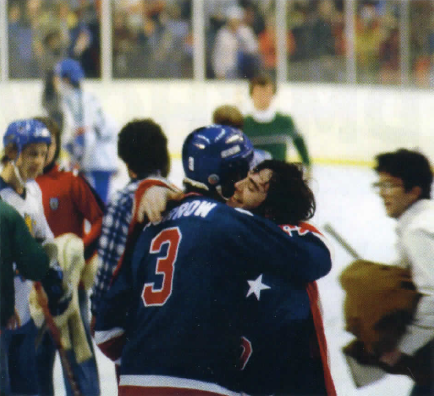
Jim Craig with defenseman Ken Morrow.
Jim Craig doesn’t think the gold medal is the best thing that’s ever happened to him. That sounds astonishing, but given his explanation, it isn’t surprising at all.
“I always tell people, don’t ever let your memories be bigger than your dreams. It’s like, Michael says nothing could have topped that. To me, that would be really boring if nothing could have topped that.
“This year we had our granddaughter Shae, first time my wife and I would be grandparents. That’s the next greatest thing. My daughter got married in the year before that. My son got married and had me as his best man at the wedding, which my father was for me.
“There are so many next best things that I don’t want to look back at something 40 years ago and call it the best thing that happened to me, because it isn’t. It was one of the best things, but it certainly isn’t the best thing.”
As a grateful nation continues to treasure the memories 40 years later, millions of Americans can share our goaltender’s outlook.
The Miracle On Ice wasn’t the best thing that happened to America.
But it certainly was one of the best things.
Did this post make your day a little bit?
I hope so. If it did, I would really appreciate your support.
When you use this link to shop on Amazon, you’ll help subsidize this great website…at no extra charge to you.
Thanks very much…come back soon!

Manny Guerra, star goaltender of the gold medal-winning U.S. Paralympic hockey team.
Another Miracle On Ice
If you love the story of an determined underdog hockey team beating overwhelming odds, and winning a gold medal in the last moments of a match to thunderous chants of “U.S.A!”, have a look at a YouTube video called “2002 Paralympic Sled Hockey Video 18”.
It’s the final shootout between the U.S. and Norway for the Paralympic gold, that ends with Manny Guerra winning it for the U.S. with an outstanding save. The hair-raising moments just in this short video build up an excitement that automatically conjures up memories of Lake Placid.
You would think the athletic world wouldn’t underestimate hockey players wearing USA jerseys, especially when playing on their home ice. But in 2002, the USA Men’s Sled Hockey Team were ranked sixth in a pool of five teams for the Salt Lake City Paralympics. The fifth ranked team? “TBD”.
Former Bruins star Rick “Nifty” Middleton, the coach of the team, told Boston Sports Desk that “We were only there because we were the host team.”
But as sports fans in this town well know, Middleton is no stranger to excellence in hockey. 448 goals and 540 assists are totals that get your number hanging from the rafters at TD Garden.
Middleton understood commitment, and he saw it in this team. Getting out of bed at 5:00 AM to greet the players for a 6:00 ice time practice, he saw a silhouette of wheelchairs in the morning sun, beating him there. Just two weeks after the September 11 attacks, none of them were unwilling to fly to Buffalo and start training to represent the United States.

Never underestimate U.S. hockey players, especially on their home ice.
Before an almost empty arena, the team managed to survive and triumph in their first game against Japan. The next game, to a packed house, brought back memories of Czechoslovakia…the U.S. dominated Canada, the number one seed, by a score of 5-1.
A hard fought 2-1 victory against second-seeded Norway…who had won the gold in Nagano in 1998…followed, and the U.S. team then trounced Sweden and Estonia to once again take on Norway for the gold medal.
Before a crowd of over 8,300 fired up Americans chanting “U.S.A!”…a sight that was no doubt familiar to any American over 30 who was present…the U.S. and Norway fought to a 3-3 tie and through a scoreless 10-minute overtime period. With the audience probably having bitten off their remaining nails, the game went to a shootout.
In the shootout, the U.S. fell behind 2-1 before Chris Manns beat Norway goaltender Johannsen high on the stick side, tying the shootout. Then Kip St. Germaine sent another into the top shelf to give the U.S. the lead.
And once again, it was up to a goaltender.
Manny Guerra, like Jim Craig before him, was equal to the task, stopping two tough breakaways to give the U.S. the gold in Salt Lake City.
Today Middleton, along with assistant coach Tom Moulton, are working with filmmakers Yaron Kaplan and Arthur Bonner to make a movie called “Tough Sledding” about the improbable victory on ice that came 22 years after the 1980 U.S. hockey team stunned the world.
Nifty, today the president of the Boston Bruins Alumni Association, has said that nothing he accomplished in ice hockey…and he’s accomplished quite a bit in ice hockey…gave him a greater thrill than seeing the U.S. Paralympic team take the gold.
You can find out more about this equally miraculous upset, and the accompanying film in the works, at www.toughsleddingthemovie.com.
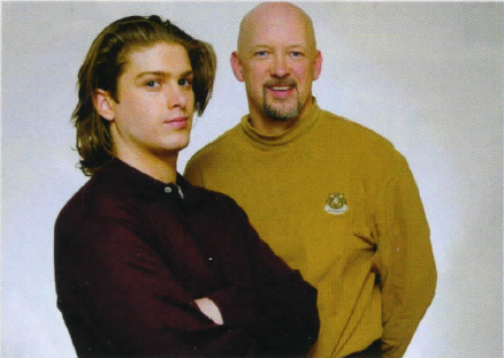
SSG Michael Mantenuto, with the hockey player he portrayed in Miracle.
SSG Michael Mantenuto, 1981-2017
Michael Mantenuto, the talented young actor who portrayed Jack O’Callahan in Miracle, did much more for his country than play a hockey hero in a movie. He became a national hero himself, enlisting in the U.S. Army and serving abroad in Operation Inherent Resolve, dedicated to defeating ISIS in Iraq and Syria.
Mantenuto was an even better soldier than he was an actor. He was a highly decorated Green Beret and Special Forces Communications Staff Sergeant, returning home with quite a few medals of his own for his service.
Tragically, on April 24, 2017, Mantenuto was found dead of an apparently self-inflicted gunshot wound. He left behind a wife and two children.
O’Callahan is, of course, aware of the story.
“Four or five tours in the military, who knows what he went through over there. It’s just a horrible thing right now,” he sympathizes. “22 military veterans are killing themselves every day in the United States. It’s awful. And Michael’s one of them, and maybe I can help tell the story from the athletic side and transition into the military side.
O’Callahan recently made an appearance in Boston, with Navy Seal Jason Redman, to speak for the Concussion Legacy Foundation. The Foundation supports athletes and veterans who have suffered brain injuries. You can visit their website at https://concussionfoundation.org/.
“We just can’t keep ignoring this,” he says. “Michael was the victim of this. I feel terrible for him.”
Here in New England, several outstanding foundations are dedicated to helping our returning heroes reclaim their lives. Please consider supporting them.
Skate For The 22 was founded by Army and Air Force veteran Bobby Colliton, who himself has lost four friends to suicide. They offer skating and hockey lessons, at no charge to veterans, along with an opportunity to be part of a team environment again.
The New England Center and Home For Veterans is dedicated to helping veterans who are at risk of homelessness achieve economic self-sufficiency and live independently. Their programs include vocational training, residential and meal services, and transition into housing.
The Home Base program, operated by the Red Sox Foundation and Massachusetts General Hospital, is dedicated to supporting and treating veterans suffering from the “invisible wounds of war”…including PTSD, anxiety, depression, substance abuse and other struggles.
Skate For The 22’s Facebook page: www.facebook.com/skateforthe22
New England Center and Home For Veterans: https://www.nechv.org
Home Base: https://www.homebase.org
Boston Heroes
Jim Craig, Mike Eruzione, and Jack O’Callahan are all Boston U. alumni. With teammate Dave Silk, they are sometimes referred to as the “B.U. Four” on the U.S. team.
All three were born and raised in the Boston area, the same place where mobs took on British soldiers, threw chests of tea into a harbor, and began an underdog revolution of their own.
O’Callahan grew up in Charlestown, just steps from the Bunker Hill Monument. He tells an amusing story of a mini-squabble with a reporter following the gold medal victory.
“After we beat Finland, Mark Pavelich and I got drug tested. Pav and I sitting in there with two Finnish guys, while the whole team goes across the street to this big press conference. They’re feeding us Kirin beers, these Japanese beers. So Pav and I pounded like three of these beers down.
“By the time we get back to the locker room, it’s empty cause the team’s across the street. So we took off our skates, we put on our sneakers and we run across the street. We have a blast, and this Boston writer says, I have a question for O’Callahan.
“I’ve already got like three, four beers in me, right? He’s like, how’s it feel to be the first person from Charlestown Massachusetts to win a gold medal? And so I said, you know what? The Americans won at Bunker Hill, and the Americans won at Lake Placid.
“So some other writer goes, ‘Back to O’Callahan, by the way, the Americans lost at Bunker Hill.’
“I was like, hey man, there’s a fricking monument outside my house. If it was a loss, they don’t build the monuments. Figure it out!”
“It became this bumper sticker in my town: ‘We won at Bunker Hill and we won at Lake Placid.’
“Charlestown is right on the water. There’s an old Navy Yard and the USS Constitution is moored there, the Freedom Trail goes right by my house. So I was pretty wrapped around the whole aspect of USA, patriotism and military and all that stuff.”
As far as being an inspiration of American patriotism himself, he says, “I’m proud of that, you know, because I love this country.”
(all photos except for the Bunker Hill Monument courtesy of BostonMan Magazine.)
Photo credit: LABabble on Best Running / CC BY-ND
This article contains affiliate links. If you click on one of the links and make a purchase, this website earns a commission at no extra cost to you. Thanks for your support.
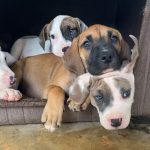
It’s A Dog’s Life – Animal Aid USA
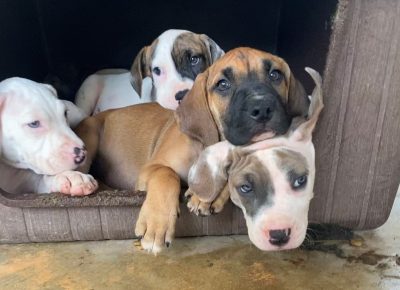
The volunteers at Animal Aid USA take a trip to rural Georgia every four weeks, to rescue stray and abandoned dogs and give them a home. To date they have rescued 40,000 dogs from unimaginable conditions. This story appeared in the spring 2023 issue of JerseyMan, you can read the magazine version here.
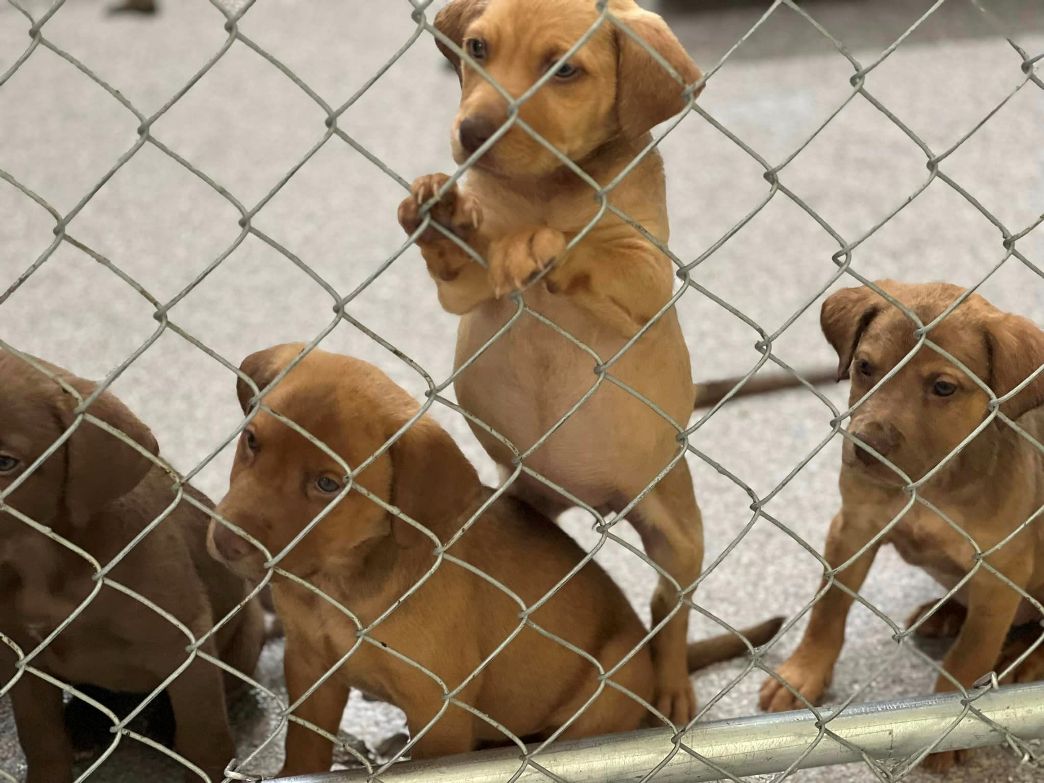
You want to give them names already, don’t you? (photo courtesy of Karen Talbot)
It’s A Dog’s Life
Our canine friends teach us one of the most important lessons of life: it’s too short for anything less than unconditional love, compassion and forgiveness, all the time.
Karen Talbot, Rachel Monaghan and the volunteers at Animal Aid USA have taken that lesson to heart. Their mission is to return the favor of unconditional love, to as many dogs as possible.
As anyone who participates in their rescue caravans can tell you, it’s a big challenge. Talbot herself says it’s not for everyone. “It’s grueling on that road.”
Animal Aid USA gathers volunteers, vehicles, water bowls, blankets, crates, and whatever else is needed, for a trip to rural Georgia from Williamstown every 28 days. They then gather abandoned dogs from local shelters in the area, load the dogs into vehicles, and take a 16-hour overnight drive back to New Jersey, to place dogs with no-kill shelters to be adopted.
A 64-word paragraph can’t begin to capture the level of effort involved in the operation. Monaghan, a regular volunteer, describes the process:
“We leave at 6:00 at night and arrive in Georgia around 9:00 AM the next day,” she explains. “Once we get down there, we prepare our vans with water bowls and line all our crates. If we have litters of puppies in our vans, we’ll extra line the crates, because we have to usually change them while we’re driving.
“That’s usually on a Thursday. Friday is when we do all of our preparation. In the morning, we’ll clean kennels again, and then we prepare for transport. We usually have about 30 crates in each van, we put in puppy pads and towels or blankets in all the crates. Karen tags them all, so we know which dogs are gonna be in our van. We prepare extra water bowls, extra towels and stuff to clean up any messes that happen.”
“At around 4:00, we start the load, we’re out of there by 5:15. Everyone’s just going in every direction. It’s like all hands on deck.”
Talbot, who spends much of her life preparing for the trips, likens it to a Broadway production.
“All of the preparation and the dress rehearsals and everything that you have to do lead up to one moment, and that one moment is “It’s load-up time”. That’s when everything has to be done done done, because the first dog in is gonna be in there the longest, and it’s all about getting them all in the right crates, and making sure everybody fits.
“Once they’re all in, we do our giant prayer circle and we’re off.”
The crew of vehicles with its precious cargo, including the rig mostly driven by Talbot’s husband Dante, then drives through the night…the only time D.C. traffic on I-95 is avoidable…back to New Jersey, where dogs are unloaded and placed with Animal Aid USA’s adoption partners. The project is both exhilarating and exhausting.
“Then you get home and you crash,” Monaghan laughs.
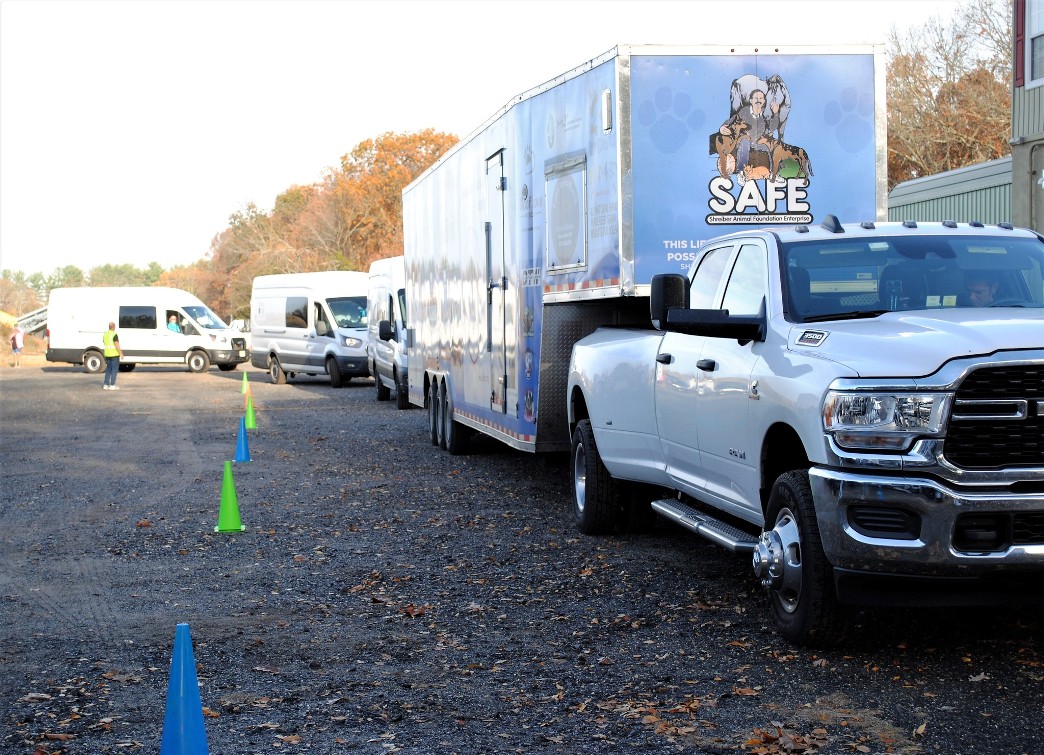
A truck full of dogs headed to be adopted in NJ. (photo courtesy of Karen Talbot)
So why rural Georgia, 16 hours away, every four weeks? Surely there are plenty of stray and abandoned animals in New Jersey?
Probably. But in Georgia and several other states, many rural counties don’t have the resources to care for stray dogs. Sadly, it isn’t often even for a lack of funding. There’s simply a different attitude towards dogs in the places where the caravan goes.
It was quite the culture shock for Talbot, as it would be for any animal lover.
“Animals are not viewed the way they are up here,” she says. “They’re not household pets, they’re not family members. They are yard dogs, they’re a nuisance.
“They don’t have the same empathy and compassion. The majority of people could care less about animals, and the minority of animal lovers are really fighting a bad war.”
She remembers witnessing how the situation reaches a tragically mind-numbing level for many people.
“When I first started going, I was so angry with them at first. Like, ‘Wait a second, you mean to tell me that you love animals, but you drove past a litter of puppies on the side of the road? What the hell kind of an animal lover are you?’
“But as I got to know these people, I realized they have 40 dogs at their house because they stopped 40 times, and now they can’t feed their families, now they don’t have food. They’re being threatened with eviction, they’re being threatened with divorce. They have to put blinders on, because sadly that’s where they live.”
Like all of the volunteers, after being a part of so many caravans, Monaghan has seen heart-wrenching stories of dog abandonment too.
“There was a case where, I guess the person went to jail, there were these Chihuahuas. The house had to be condemned. It was so disgusting, they were living in layers of poop and pee, it was just horrible. And again, the police, they didn’t want to deal with it.”
Monaghan laments that “All the shelters are pretty much kill shelters. None of them do public adoptions or rescue. If they’re not claimed by their owner, they usually get euthanized.”
Talbot describes the horrific conditions that dogs endure. “They’re not even shelters. They’re death holes. They’re a cinder block hut with a car port over top that they call a shelter. There’s no A/C, there’s no heat, some of them don’t get fed. They’re just there to hold until they’re killed.”
Hearing the stories can take an observer from “Why do people do all of this to rescue dogs?” to “How can anyone with a heart not do something?”

Rachel Monaghan (right) with a new bestest buddy. (photo courtesy of Rachel Monaghan)
In Rachel Monaghan’s case, she wanted to do something to overcome her grief after losing her own dog unexpectedly. She learned about Animal Aid USA through a friend, and has been hooked ever since her first trip.
“I was planning on going to three trips that year,” she remembers, “and I ended up going on I think six. I just became a regular caravan member.
“The best part for me is seeing the transformation. Obviously it’s awful what they go through, but seeing the resilience of them, and how they just still continue to love and trust people.”
Talbot says of the people giving their time to the caravan, “I’ve discovered that it’s not just them saving dogs. This movement has saved them. It’s saved their marriages, it’s stopped them from drinking, it’s made their life better at home. It’s their outlet to get away for a while to do something bigger than them.
“Nobody gets that until you come on a trip. Our motto at camp is ‘Our strangers leave as family’. And it happens to everybody. If you have a soul, it happens to you. It can’t not.”
In the face of a mentality that has existed for generations in this part of the world, Talbot and her team have taken on the most difficult of tasks: not just rescuing dogs…over 40,000 of them now…but also changing an established mindset that creates the need for their rescuing.
“You see it, in just the blank stares,” Talbot says. “People cannot believe that first of all, we would drive that far for a dog, and second of all, why?
“What we’ve learned is with our continuous journeys there, and the trust that we’ve built with these people. They know we’re not there to do anything except help. We want to change the next generation, we want to break this cycle, which we are.”
Talbot has seen that transformation in personal relationships, such as with a hardened animal control officer who now reaches out to Karen for help with dogs he finds.
“We laugh about it today,” she reflects. “When he first met me, he grunted at me, wouldn’t even make eye contact with me. I said look, I’m not here to point fingers, I’m here to help.
“A couple of years went by and he started to talk to me, he gave me his cell phone number. Then a couple of years later he was just like, ‘Hey, Karen, listen, I got so and so dog that just came in, you think y’all can take this one?’
“And this relationship blossomed. Plus some Tastykake cupcakes from up here helped too,” she adds with a chuckle.
Karen Talbot doesn’t spotlight her own role in rescuing dogs, even though it’s considerable. To her, it’s simply her life’s work. She always emphasizes the word “we” when speaking of the efforts of everyone involved.
“I had an idea, and I had a vision, but a vision is just a vision unless an army comes together to actually make that vision become a reality. We’re all volunteer, it’s just a life-long mission of ours.”
By providing the education, awareness and resources, she says, “We are empowering the next generation to make change in their world for companion animals. You’ve got rescue groups all over. But are you changing the mindset while you’re doing it?
“We are, and I think that’s what I’m most proud of.”
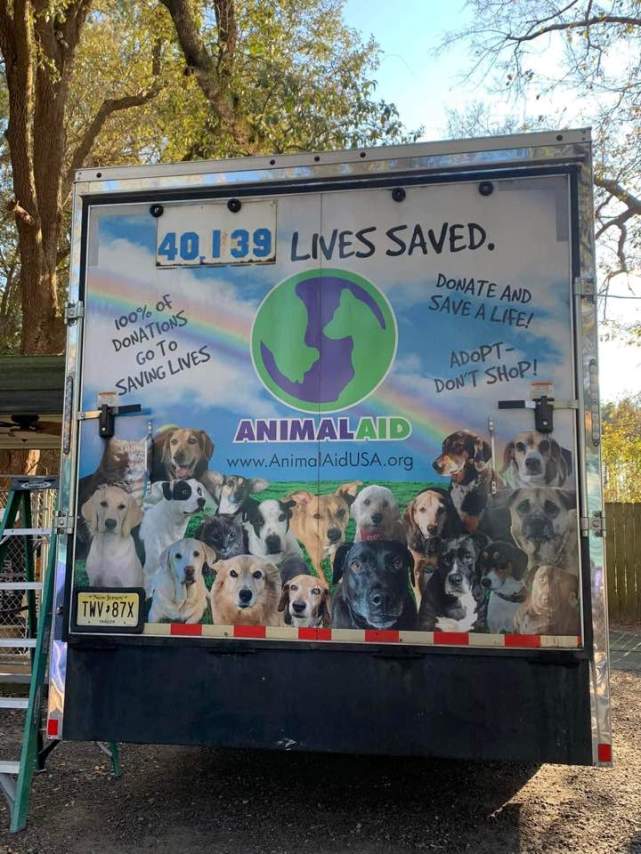
And counting. (photo courtesy of Karen Talbot)
An Animal Loving Bachelor
The rescue caravans at Animal Aid USA operated under different names in its early years, including MOMS (Making Of Miracle Stories) Rescue and Paws For A Cause, as Karen Talbot worked to raise awareness of dog rescues in rural Georgia.
Talbot fondly recalls the story of the huge contribution from Lorenzo Borghese, a name you may know…he was The Bachelor in the show’s ninth season. Borghese is an animal lover himself, and he wanted to help when he saw a documentary about the rescue operation.
As Talbot understood, his endorsement meant far more than a financial contribution he could have made.
“I was contacted by somebody who knew Lorenzo,” she remembers. “They wanted me to get introduced because (Talbot’s husband) Dante and I had started to take trips to Georgia. We went on our first trip in January of 2011, and on that trip, we had a borrowed van and we went down for 23 puppies.
“Once I met with Lorenzo, what I loved about him was there weren’t layers to get to him. He was the real deal, he reached out to me personally. I gave him a copy of the documentary which we had done.
“He knew that Dante and I were going back and forth to Georgia and funding everything on our own dollars and credit cards. Once he left our meeting he went home, watched this 25-minute documentary and was hooked.
“He said, ‘Are you looking for a check? Are you looking for money?’ I said, ‘No, I don’t want your money. I want something more important. I want a voice. People know who you are, they recognize you, they don’t know me.’”
Borghese suggested creating Animal Aid as an umbrella for MOMS Rescue, which he then lent his endorsement to. The “USA” was added when they learned that another “Animal Aid” already existed.
“That’s when Animal Aid was born, and so we incorporated Animal Aid is a non-profit. All the while, I still kept Making Of Miracle Stories, and Animal Aid just took off.”
Borghese adding his voice undoubtedly helped the effort. Talbot made a wise choice asking for it over a check…which she says would have been spent in a week and immediately forgotten.
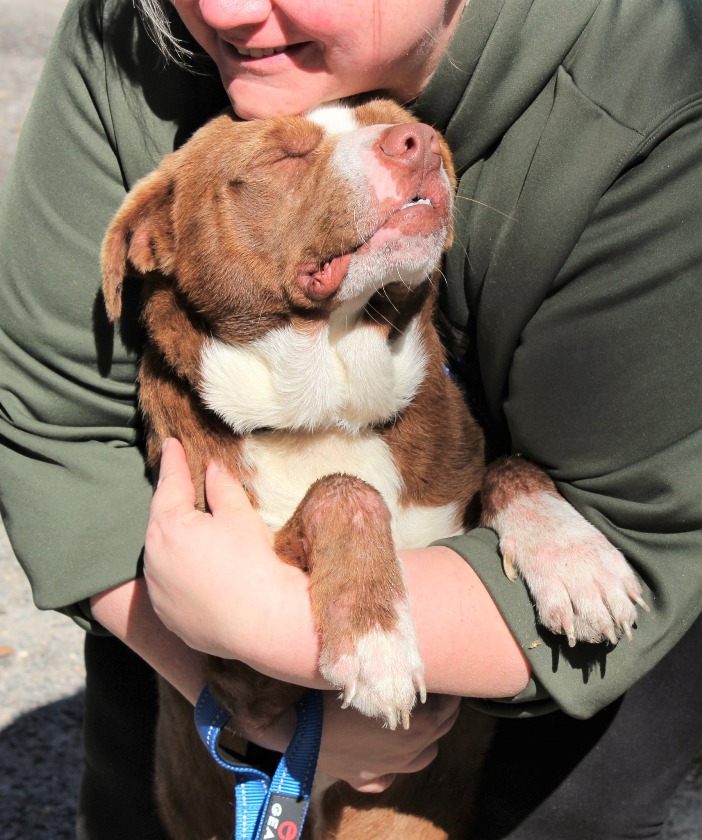
Being adorable in their natural state. (photo courtesy of Karen Talbot)
The Video
On the Animal Aid USA website, you can watch a video of their being featured on “To The Rescue” docuseries, with host Tommy Habeeb narrating the full experience of the caravan going back and forth from Williamstown.
The video shows the Georgia compound where dogs are held until the caravan arrives, as well as the medical facility where vets handle spays, neuters, and heartworm treatments. Habeeb hears about the entire process from Talbot, who describes the logistics from dog food deliveries to the 38-foot transport rig that holds 64 crates.
Throughout the video, you see Georgia dogs in their natural state of being adorable, making the work that Talbot describes as grueling seem not only worth the effort, but not difficult at all. But Talbot shares that people are exhausted by the end of the project, wondering what they’ve signed on for, until the sun comes up during the ride home and they see the light at the end of the tunnel.
The caravans could easily be a reality show, you might think while watching. But Talbot is quick to shoot down pitching the idea of a reality show to a network, as this writer suggested.
“It’s a real reality show every 28 days down there,” she says. “But for me, living it on a daily basis and being in Georgia…Rachel’s amazing, it’s not a bad idea for her to set up a YouTube channel with a following, where we are real and raw.
“You’re not getting raw in reality TV. And you’re also controlled, and it’s scripted, and I am the furthest from being controlled or scripted.
“They don’t like that at all!” she says with a laugh.
The video is well worth a watch…go here to see it.
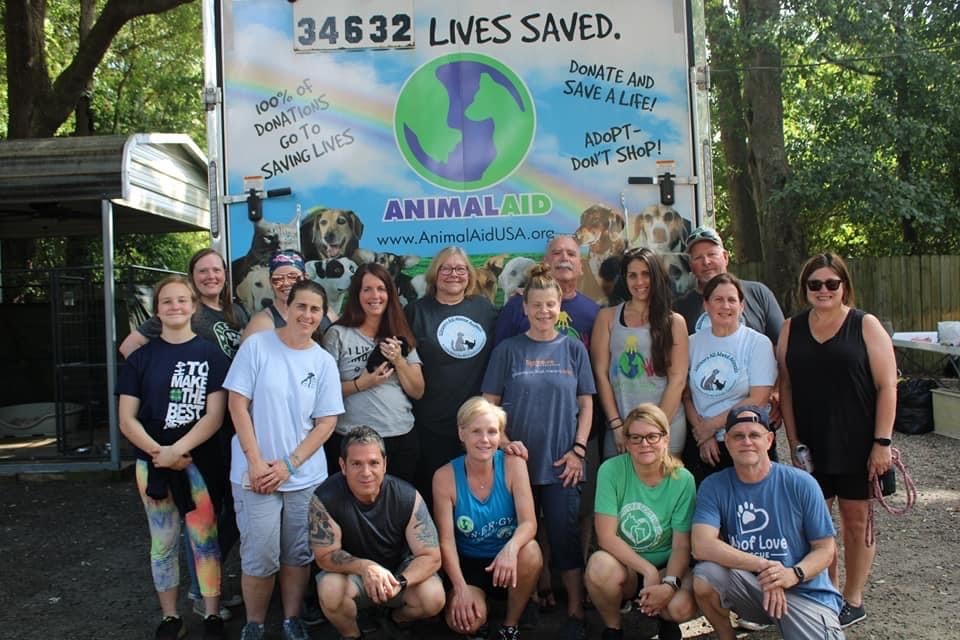
You are welcome to come join them. It’s life transforming. (photo courtesy of Rachel Monaghan)
Put It On Your Bucket List
Karen Talbot and Rachel Monaghan were happy to invite this observer to join them for a caravan trip. It’s something to consider, even if you just like long overnight road trips and need a worthwhile reason.
As Talbot says, the caravan has even saved marriages, and she cites her own as an example. Her husband Dante, who now drives and maintains the big rig of the caravan, had at one point tired of her devotion to the cause and requested a divorce.
“I immediately chose the dogs,” Talbot says.
“The following summer after the giant Georgia puppy caravan, we then had our documentary premiere in Philadelphia, and all the people that came on the caravan…the pilot, the rescue groups, everybody, was in attendance at the Trocadero.
“Dante was there because we were still friends, and he saw what I was doing from our bedroom on a computer, and he vowed to make it up to me the rest of my life if we got back together.”
The power of puppy faces. “It’s really funny because the reason we divorced was dogs, and once we re-married and got back together again, he’s worse than I am with dogs.”
Hopefully your marriage isn’t in need of helping dogs to save it, but if you’re interested in lending a hand and the life transformation that all of the volunteers speak about, you can reach out on the Animal Aid USA website and see if they need help with the caravans, which they usually do.
“Put it on a bucket list at least once in your life,” says Talbot.
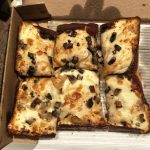
Foodie Hall in Cherry Hill

The best assignments a writer could ask for are the ones that include free food…but especially when that food is from recipes concocted by gourmet chefs. JerseyMan sent me to cover the opening of FoodieHall in Cherry Hill…a great place for outstanding grub. Check out the article from the magazine here.
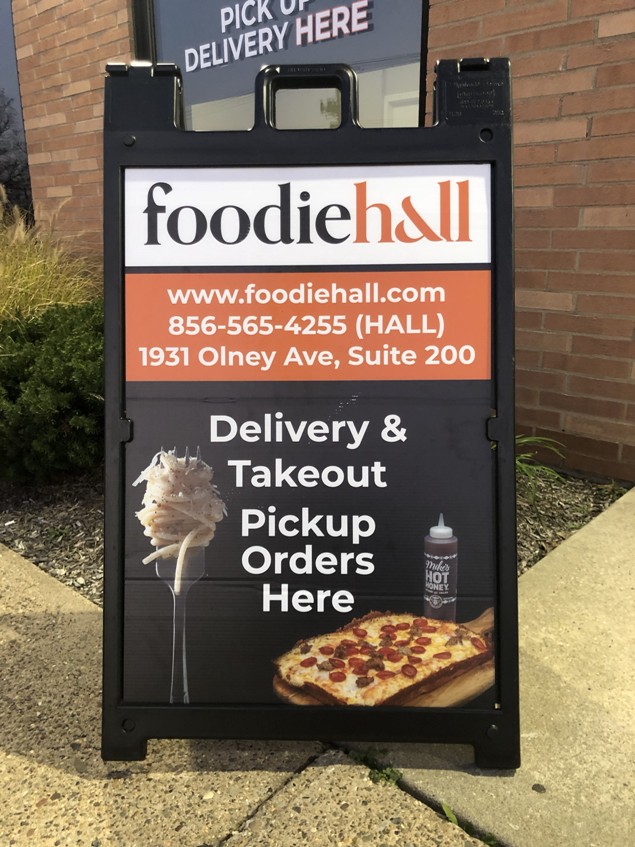
Hall of Food
The new Foodie Hall in Cherry Hill is a revolutionary concept – first rate food prepared specifically for takeout and delivery, while offering something for every taste.
For you JerseyMan readers and Legacy Club faithful, since membership has its perks, we’re about to share privileged information with you. If you’re on a plane or train, check that no one is looking over your shoulder, and that there are no surveillance cameras nearby. We’re entrusting you as someone with a need to know.
Here it is: You can now get a Geno’s cheesesteak in South Jersey.
Okay, maybe it doesn’t sound that momentous. Tony Luke’s, Primo, DiNic’s and other iconic Philly sandwich shops have all opened outposts across the Delaware, sparing their enthusiasts in our neck of the woods considerable congestion.
But for Geno’s, expansion from its 56-year South Philly location has been minimal. You can find a couple of locations in the city, like the airport. But until very recently, a Jersey dweller had to pay bridge toll to sample a Geno’s cheesesteak.

It’s the meat. Geno’s won’t have it any other way.
Dan Goldberg, co-owner of the Foodie Hall in Cherry Hill that now offers the essential Philly sandwich, helped to make this unprecedented happening possible.
“We’re very excited about it,” Goldberg says. “Our PR firm had a relationship with Geno, and made the introduction. We pitched Geno on the idea, and surprisingly to us, he was receptive.
“Geno’s has never expanded outside of Philadelphia, ever. So for us, this was a really exciting opportunity. Geno toured our facility, was very impressed with the layout, the cleanliness, and the whole thought that we put behind it, and said he was interested.”
And so you know, Goldberg didn’t just throw a few bucks at Geno Vento to use his signage. Thankfully, Geno is more protective of his brand than that.
“We worked out our deal, and went through extensive training with Geno to make sure that the Geno’s steak you have here in Cherry Hill is the same Geno’s steak you’ll have in South Philly. Which is not only important to us, but obviously important to Geno as well. It’s literally his name on the marquee.
“Geno was adamant, because he’s approached all the time, he wants to make sure there’s consistency across his locations.”
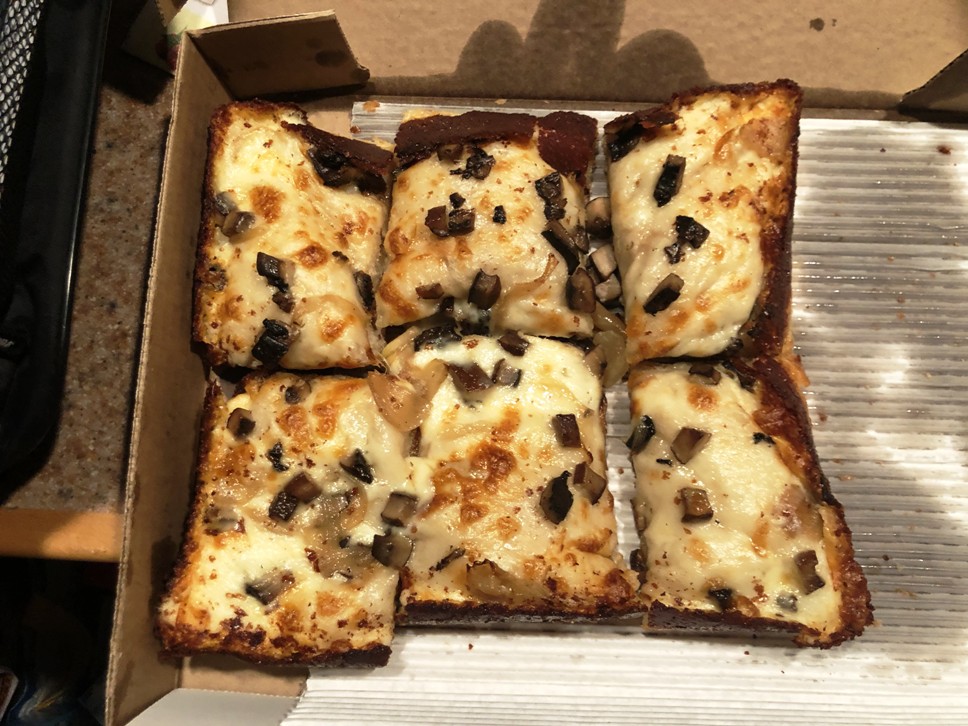
Not just Detroit-style pizza…Detroit-style pizza created by a gourmet chef.
To successfully persuade Geno’s to be a part of Foodie Hall is obviously a significant accomplishment. But it gets better.
Foodie Hall opened for business in May of 2022 offering a novel idea…multiple types of cuisine available for takeout and delivery. No more settling, they proudly proclaim. If your family bickers frequently over what to get for dinner, or your sports watching buddies can’t decide between pizza or burgers, Foodie Hall is your solution.
To be sure, maybe any-cuisine food delivery isn’t what you’d call a novel idea these days. As many restaurants in New Jersey were forced to close in response to a virus, many of them were offering takeout and delivery options to stay viable. If your local diner was doing this, you could probably choose from a varied menu and have DoorDash or GrubHub bring it to you.
Foodie Hall is revolutionary in being designed for the purpose of delivering higher quality food…whether it’s tacos, chicken sandwiches, or dumplings. Hop onto their website and order from menus that include Detroit-style pizza, Korean BBQ burgers, chicken Quesabirria burritos and much more. All chef-inspired creations.

Since the pandemic, the trick is to keep food warm.
In case you’re wondering, Foodie Hall wasn’t conceived during the pandemic. But the sudden pivot towards takeout and delivery definitely gave the idea a boost.
“In 2018-19,” Goldberg remembers, “my original founding partner (Nick Ballias) and I, we met at a food event that I co-chair, called Men and Women are Cooking, that raises money for the Atlantic City Boys and Girls Club. This was when GrubHub, Uber Eats and DoorDash had come to Atlantic City, and it was starting to blow up.
“We started coming up with an idea for a delivery-only restaurant. We had penciled this out already, and then Covid hit and restaurants closed, and all of a sudden everyone was ordering delivery.
“My parents were telling me how they had ordered Morton’s for dinner. That’s when it struck me, there are people whose consumer habits have now changed and will never go back. It’s no longer just wings and pizza. There’s my parents, who are not exactly the most tech savvy, ordering steaks for dinner, that means anybody can be ordering everything.
“So why not come up with a restaurant concept that had multiple different types of cuisines on it? We ran into this family idea, where the parents want adult food and the kids want pizza or mac and cheese. Or the parents can’t agree. Or you have a group of friends watching football and they all want something different. Rather than settling, let’s have something for everyone.”

The conveyor belt. It seems so obvious if you’ve owned a dry cleaning business.
Sounds great, but how could that all work? A conveyor belt is a big part of it (!), but Goldberg says every step of the process matters.
“We put a lot of thought into what delivery trends were taking place, what was working and what we saw that wasn’t working,” he remembers. “Packaging was a big piece of it. Many restaurants during the pandemic that were doing delivery kind of out of necessity were using takeout packages. Those packages are not meant necessarily to be reheated, or to be leak proof, or to sit in a car for half hour or to retain heat or cold.
“We looked at packaging specifically meant for delivery. We wanted something that would maintain heat and not leak. We literally made products in our kitchen, put them in different containers, and had them sit in our parking lot for half hour or drive around and see how they held up. We wanted packaging that would be eco-friendly, and also able to be reheated in microwaves and ovens and things.”
Then there’s the little matter of creating a wide variety of cuisine from one kitchen, maintaining quality, and somehow keeping overhead down.

Some ingredients are astoundingly versatile.
“We are very conscientious in the ingredients we use to be cross-utilized across all the platforms. For example, chicken breast is used in multiple products across the different restaurants. I have a chicken parm sandwich at Criss Crust, and we have the chicken sandwich concept, Simply Fowl, and then we have salads that have grilled chicken on them. We’re trying to use things across and that keeps us more efficient.
“When we designed the kitchen, we were concerned with having a traffic issue, with people walking around and bringing all the various foods to the front. It would have been a waste of labor. We came up with a solution which I borrowed from my old business…a commercial laundry business…where we had a conveyor belt. It’s a 120-foot conveyor belt that runs down the center of our kitchen.
“I don’t need people running up to the front and bringing the food, I don’t have to worry about people walking into each other. It’s a way to keep costs down and keep order in the kitchen.”
The conveyor belt concept is indeed impressive to witness. An owner of a busy diner might see it and wonder how in the world they didn’t think of it.
“No one’s ridden on it yet that I know of,” Goldberg jokes.
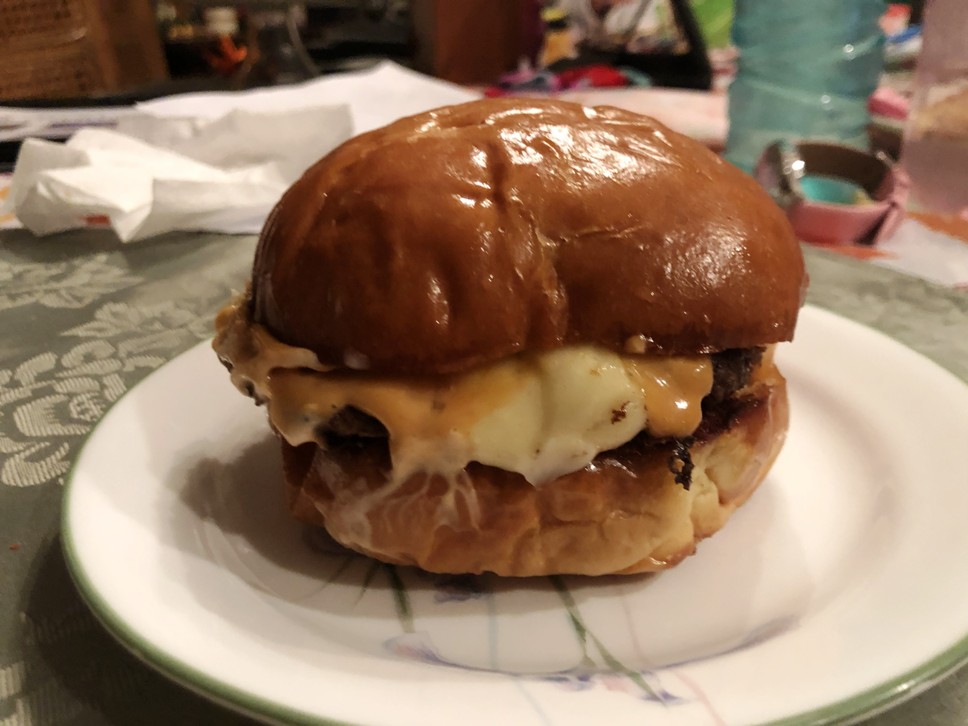
Craft burgers. Just because craft burgers.
JerseyMan loves telling readers what makes life in South Jersey great and highlighting business ingenuity among our own. Places like Foodie Hall give us plenty to work with.
In the days before smartphone maps, you might have had a difficult time finding the place. It’s situated in an industrial park in Cherry Hill, just off of Route 70 but requiring navigation of annoyingly tricky jug handles and intersections. If it were a sit-down restaurant, the difficulty getting there might be a factor in your going elsewhere.
But for this style of eatery, the location is the beauty of it.
“We are delivery and takeout only,” Goldberg says. “We need to be near people, and we need to be near businesses, but I don’t need to be on Route 70 or Route 73. I just need accessibility, I don’t need visibility. We built out this really high-end large kitchen, with the latest and greatest in equipment, but I’m not paying the prices I would pay to be on Route 70 or 73. It’s more economical to be here.”
Market research drove the location of Foodie Hall’s first outpost in Cherry Hill. Even though it seems obvious.
“Between Cherry Hill and Mount Laurel and Maple Shade, you have a tremendous number of people that are foodies. It really fit well for us.
“It has a great mix of residents and businesses. We can cater to people in their homes at nights and weekends, and our concept lends itself perfectly to office orders and catering during the day. We’re getting a lot of offices that typically order once a week, same idea as from home. Instead of having 20 people fighting over what we’re having for lunch, now 20 people can get what they want in one delivery.”
Including an authentic Geno’s cheesesteak, without the tolls and traffic.

“Wow, you can get DaNick’s here?”
Establishing The Brand(s)
Foodie Hall features eight restaurants under its umbrella as this sentence was written, including Geno’s Steaks, an instantly recognizable brand to Philly area natives.
You can order Mexican street cuisine from Dando Tacos, Jersey fried chicken sandwiches from Simply Fowl, craft burgers from DaNick’s, Buffalo chicken mac and cheese from Mac N Toastie, or vegetable dumplings from the Cantina Wok & Noodle Bar. If you’re going Italian, try the Criss Crust Detroit-style pizza, or the antipasti from the Fornire Italian Kitchen.
Seeing the choices, a South Jersey food enthusiast could wonder how they have lived here so long without recognizing the catchy names and logos sitting alongside Geno’s. How does anyone miss Mac N Toastie?
When questioned whether the others are established eateries in their own right, Dan Goldberg considers it a triumph of Foodie Hall’s design.
“I’m glad you asked that,” he explains, “because they’re not. The fact that you asked that question means we did a good job of branding and trademarking to look like they are established brands. And the idea is that these brands will proliferate and open up in other Foodie Halls.
“There was a lot of thought given to the name, the logo, the design, the color scheme, to make it look like a franchise or an established restaurant. But they’re all our own creations, we came up with them. We put the menu together, the recipes, etc.”
That includes DaNick’s, which sounds perilously close to DiNic’s, the long established roast pork sandwich destination in the region.
“No, different name,” Goldberg responds when asked about the similarity. “They’re actually named after (co-founder) Nick (Ballias) and I, Dan and Nick. Nothing to do with them, we love their sandwiches, but yes, completely unrelated.”
So foodies in the area can rest easy knowing that they haven’t missed out on Fornire’s, and a potential topic for their blog.
But if you’re one of those types, the clock’s ticking on trying out Foodie Hall before your blogosphere competitors do.

You’re probably pretty good at cooking if you’re seen with this guy. (photo courtesy of Georgeann Leaming)
Key Players – Georgeann Leaming
Dan Goldberg and co-founder Nick Ballias don’t mess around when it comes to takeout fare for discriminating South Jersey natives. While working out the plans for Foodie Hall, they considered product quality important enough to bring a chef on board to be a culinary consultant, and design recipes for their menu of food creations.
Not just any chef, by the way…they partnered with Georgeann Leaming.
You may have heard of Leaming…she’s been a champion TV chef on Food Network’s Chopped, and competed on Hulu’s Man vs. Master. She’s been an executive chef for two of Gordon Ramsey’s restaurants, and has co-owned two food stops in Philly. One of them, Samwich, took Philadelphia Magazine’s “Best Fried Chicken Sandwich” prize in 2016.
That’s just a partial list of Leaming’s street creds in Philly area cuisine, but it’s enough to see why Dan and Nick would take the opportunity to work with her.
“It was very important for us to not simply have your average burger or chicken sandwich. We try to do everything higher end than your normal delivery would be.
“She left to pursue some other avenues in September, but she was with us all the way. She helped us design the menus, and some of the dishes were completely her own from top to bottom in terms of the ingredients, the recipes and everything. These are recipes that we use, and we haven’t changed anything since she left.
“Georgeann was a big help,” Goldberg acknowledges. “Fantastic, talented chef, culinary director, and really helped design and get this to where it is. Perfect person for this, and without her, we wouldn’t have the type of food that we have today.”
The decision of what to get for everyone in the room isn’t the only comestible conundrum Foodie Hall solves. If you’re looking for cuisine inspired by a top chef in the region without the triple-digit price, they take care of that for you too.
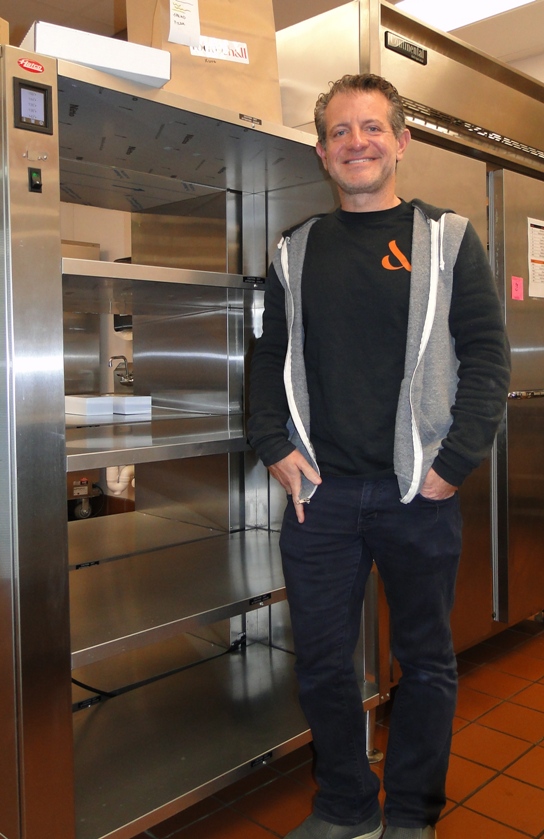
Dan Goldberg, FoodieHall co-owner, feeding people everywhere.
Meals 4 Meals
Dan Goldberg and his people consider giving back to be part of the ethos of business success, and they offer an incentive to philanthropic types who love great food. For every meal ordered from Foodie Hall, they donate a meal to Feeding America through their Meal 4 Meal program. On Foodie Hall’s website, they call the initiative “a vitally important guiding principle in how we operate.”
Goldberg is happy to explain how it works. “What they do is, they will take a monetary donation that they get a lot more mileage out of than we would, because of their immense buying power. We donate an amount to them for every meal that we sell, which is the meal equivalent for them. They use that to purchase meals for their partner charities, which are all across the country and the world.
“We initially got the idea from the Bombas Socks people. For every pair of socks that they sell, they donate a pair to people in need in a country outside of America. And we loved the idea. It made a lot of sense to us.”
So when you order from Foodie Hall, you’re not only providing all your guests or employees something for their own tastes, you’re making a contribution to a four-star organization with 200 food banks and over 60,000 programs to help feed the hungry in your own homeland. Not that you need any extra incentive to try Simply Fowl’s Nashville fried chicken sandwich, but it doesn’t hurt.
“By our calculations,” Goldberg estimates, “We’ll be donating about 50,000 meals in this year, which is really exciting. I’m very proud of that.”
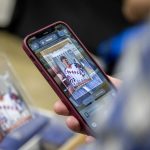
Collectors And Sons – The CollX Sportscard App
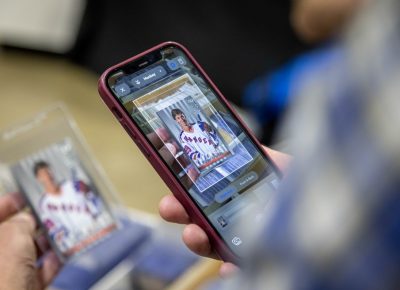
JerseyMan sent me to interview Ted Mann and talk with him about his new app, CollX, which helps sportscard collectors easily find the value of their cards. Love fun assignments like this! You can read the article on JerseyMan’s website here, or view the PDF from the magazine here.
(All photos courtesy of Ted Mann unless otherwise indicated.)
Collectors & Sons – The CollX App
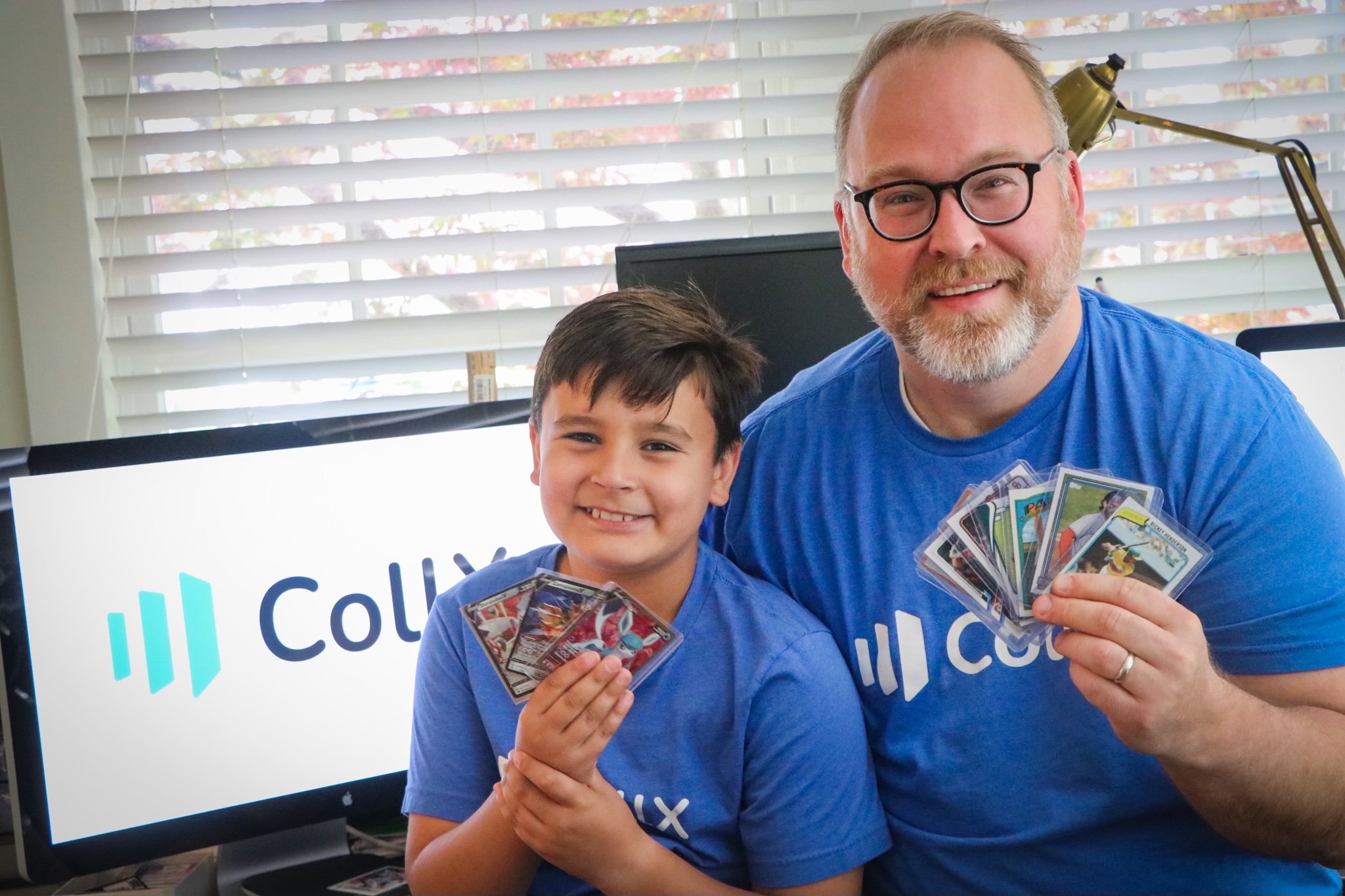
Two geniuses at work.
There is a new app available for sports card collectors that solves a decades-old problem…finding out how much your sports cards are worth. It’s called CollX, and the idea was hatched by a ten year old.
The wonderful thing about young children is that no matter how overwhelming a problem, they always see a simple solution.
And as any sportscard collector knows, finding the true value of cards is a pretty overwhelming problem.
Ted Mann, a former journalist, has just started his fourth technology company using visual search technology. It’s an app called CollX, and it’s an idea that is so obvious that adults need kids to help us see it.
Fortunately, Ted has just such a visionary living under his roof…his ten year old son Charlie, who saw how his father’s technical skills could make the world a better place.
The CollX app does the most important thing apps do…it saves collectors lots of time. With CollX, you can dig out that dusty collection of sports cards from your attic, scan each card, and instantly see its approximate worth. (Incidentally, if your cards are worth anything, hopefully you’ve been wise enough not to let them collect dust.)
No more poring through Beckett or Tuff Stuff guides, no more hauling your collection to a broker, no more countless hours on eBay. Ted and Charlie tried all those things with their collections, until Charlie suggested a better idea.
Ted gives all the credit where it’s due.
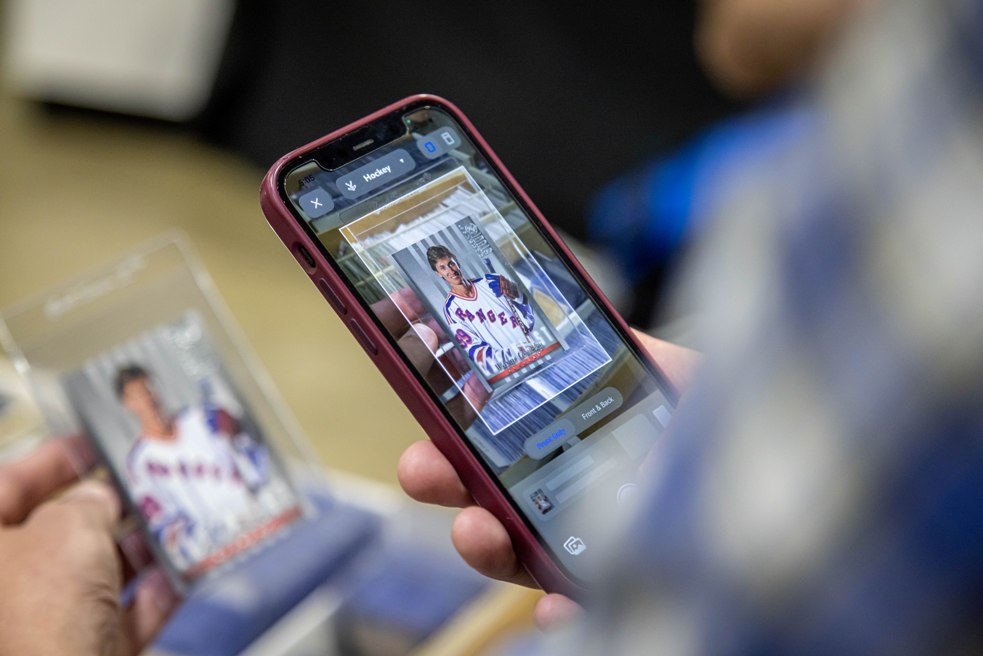
It’s obvious enough that we need a child to think of it.
“When I was a kid, I ran into the same problem that Charlie had. Tuff Stuff Magazine, listings and prices, I also used Beckett back then, looking things up manually.
“But the Beckett Guide has become like a phone book. It’s super thick. It’s really, really tough and time consuming to look these things up, and even when you do, I was finding that the prices in the Beckett Guide, probably the minute they’re published, are out of date.
“We found some apps where you could look up cards, but they were really expensive, high value cards, which sad to say, did not fit the description of my collection or Charlie’s.
“We tried one thing after another, and finally Charlie’s like, “Dad, can you just build me something that would do this?”
Cue the light bulb.

Baseball card valuation on the fly.
Childlike vision works because adults can’t believe some things can be easy, like finding the actual value of a Cal Ripken Jr. rookie card. As a result, many of us let valuable memorabilia collect dust in the attic.
Charlie provided the inspiration, but as Jersey native Thomas Edison informed us, genius is 99% perspiration. Ted is well aware of this, and he’s been putting in the sweat. CollX is all about making a difficult and tedious process easy…but developing the app itself has been anything but an easy process.
It’s not the easiest to market research, for one.
“It’s easy to go and ask people around town, do you have any cards? ‘Yes.’ Do you know what they’re worth? ‘No.’ Have you ever sold a card on eBay? ‘No.’ Why not? ‘I don’t know what they’re worth.’
“It definitely gave me optimism that there was something big here. But understanding how big a market it is was a challenge. We did assess that basically, thanks to eBay and other marketplaces. The current market size is about 5.4 billion.
“But what about all those people that have never sold on eBay? Could you get them to do it? Could you get them reacquainted with their cards and back into the hobby?
“We actually had to conduct a pretty big omnibus study to get a sense of that…just this afternoon, another news outlet called New Street published the findings of our research. The big takeaway was that there are about 85 million American adults that own trading cards.
“It’s a huge 33% of the population, and yet none of them, or I should say a small percentage of them, have ever transacted on any kind of market like eBay. The thing blocking them isn’t necessarily getting the cards graded or having access to a place to sell them. There’s still a lot of card stores, there’s a lot of online sites. It was simply not knowing what the cards are worth, and not having a good way to figure that out.
“If we can help solve that problem, then this huge addressable market can be unlocked.”
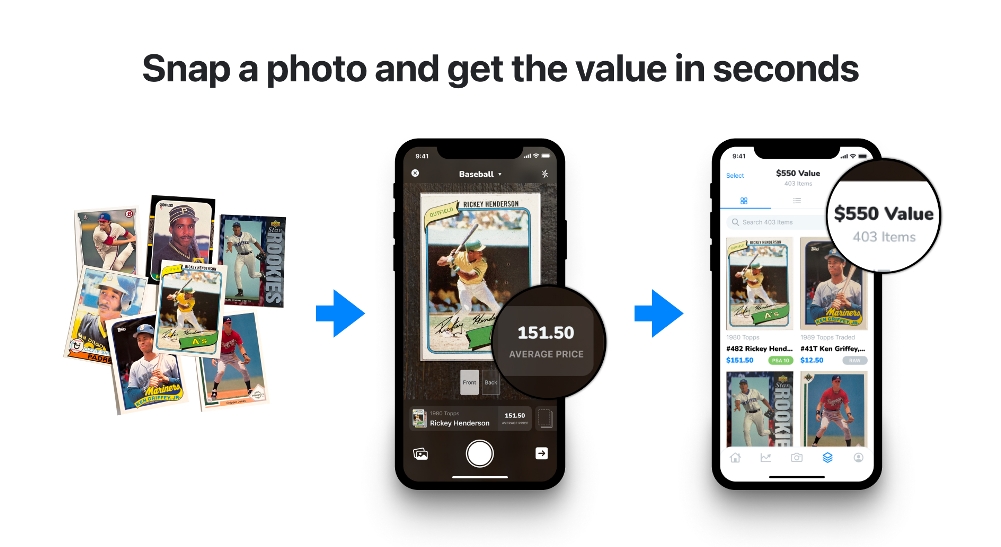
That thick book is why people didn’t bother.
There is also the sheer number of collector’s cards…the CollX database features 20 million, and most definitely counting.
It’s an ongoing process, Mann says. No kidding.
“We still don’t have every card by a long shot. There’s a few cards in my collection that I still can’t scan into CollX, because we haven’t gotten those images or gotten that data into our database yet.”
Spoken like a true entrepreneur…20 million is nowhere near enough. Just how, exactly, does a database of 20 million sportscards get constructed?
“We found a number of sites online, all publicly available sites, that have checklists. In the trading card world, you can build the set, right? And there’s a list of every card in that set. We started building those checklists, and then populating all the images for all the cards in those checklists.
“We started with baseball and then we added football, baseball, basketball, hockey, soccer, wrestling. Soon we’re gonna add trading card games like Pokémon.”
Mann says that they have also developed what he believes is a generally accurate algorithm for determining each card’s worth.
“We’ve built up a ton of pricing data, most of which is coming from other auction sites. Again, publicly available and all readily searchable, eBay being the biggest. We’re taking all of those transactions and mapping those back into the individual cards.”
Arduous task, undoubtedly.
But the CollX app keeps improving, and its usage keeps growing.

One of over 200,000 users at a given time.
During JerseyMan’s interview with Mann, a counter sitting on a nearby shelf occasionally made clicking noises and changed the number it was displaying. This counter, Mann explained, shows the number of people using the app at a given time. At that moment, the number was 232,408 and growing. There are plenty of curious collectors out there.
But Mann and Son’s E-Z Sportscard Valuation Service has bigger plans…not just helping users find the worth of their cards, but also facilitating the sale process if they are inclined, and ultimately monetizing the app through commissions.
“We’re a very early business,” Mann says. “We aren’t charging for the app. We know there are already users reaching out to other users to buy their cards…we see that happening in big numbers. We’re going to help them do that better, so we’ve created a number of tools.
“The first big tool is our deals feature, where you can negotiate on multiple cards. You can create a deal with a bundle of cards and negotiate on the lot. We’ll facilitate checkout and generate shipping labels, to ship the cards via the postal service.
“We want to help people make a lot of money on their collections. But the thing I think is really unique is, on CollX, you actually see what the buyer and the seller both have in their collections. That enables us to say, here’s the areas where you have a shared interest. If you really like the Phillies, Bryce Harper, we’re gonna surface those cards from my collection. When you add something from my collection, now here are a few other suggestions of other cards you might be interested in.
“We can build those recommendation systems in a really personalized way, and I think it creates a better experience.”
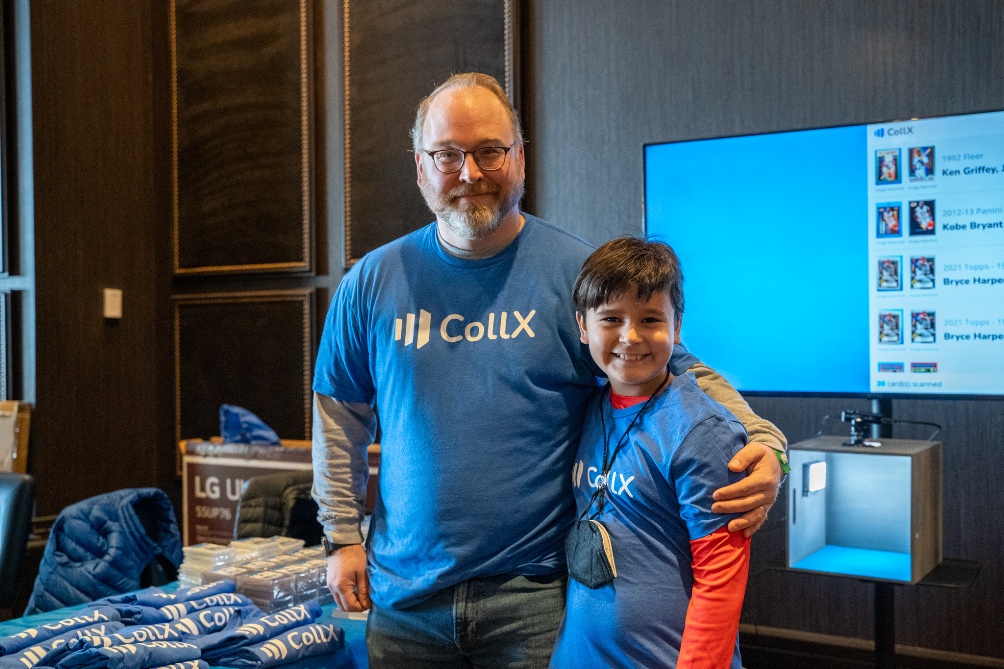
Father and son bonding through baseball cards…it’s as American as it gets.
There are few better opportunities for fathers to tell their sons about athletes of their era than when leafing through a collection of sports cards. Imagine building a business around it with your son. Charlie Mann is getting a solid grounding in both…even if he still gets more stoked about interviewing Rickey Henderson, which he did at a recent sportscard event.
Charlie is obviously not old enough to remember baseball’s greatest base thief, but as Ted says, he knows plenty about him.
“He was super excited to talk to him, because that was one of the cards that he pulled out and he was like, ‘Dad, is this one worth anything?’ I was like, ‘That might actually be the most valuable card in my collection. It’s his rookie card. Let’s go try and figure that out.
“And sure enough, it was one of the more valuable cards. So when Charlie got to interview him, he shared that story. Rickey was really nice. I was really impressed with him.”
“I love getting to do this with Charlie,” Ted continues proudly. “It’s been a great way for us to bond and connect, and it’s not just us. I’ve noticed and seen and heard from countless users on the app that it’s been the same thing for them. Just fathers and sons, getting to bond over collecting cards and to do this together. I think for Charlie that was super gratifying too. To see it wasn’t just him that had this problem.
“And he’s helping all these people.”
Sometimes, the kids really do have the answers.

No, you can’t sell a picture of the card. (image courtesy of Wikimedia)
The Honus Wagner Card
As every baseball card collector knows, the T206 Honus Wagner card is the most valuable baseball card in history. In August of 2021, the card sold for a whopping $6.6 million.
Why is it so valuable? According to Wikipedia, in 1912 Wagner was asked permission by the American Tobacco Company, who manufactured baseball cards at the time, to have his visage included on a card. Wagner refused for reasons that still aren’t clear today, with theories ranging from his not wanting to advertise tobacco to kids to his being a tough negotiator who demanded greater compensation.
As a result, just 50 to 200 Honus Wagner cards were produced, and given his stature on a baseball field, this almost immediately made the card valuable.
Ted Mann well knows the value of scarcity in collecting. It was unintentional in the American Tobacco Company’s case (then again, maybe it wasn’t), but Mann says that card trading companies do intentionally create scarcity.
“The manufacturers of these cards create small print runs for certain cards. They’ll say, there’s only ten of these cards. It’s like your golden ticket. Golden auctions sold, I think a one of one Mike Trout rookie card for like $5 million. There’s only one of them, so that creates demand.
Mann doesn’t believe a Honus Wagner card will be scanned on CollX. He stresses that the app is more for “the rest of us”.
“I don’t think we’ll see a lot of $7 million Honus Wagner cards scanned in the collection. As much as I’d love to cater to the high end of the market and have them see the value on the app, I think it’s really kind of the rest of us, the long tail of the collecting hobby that we’re really appealing to.”
The value of some cards brings to mind a potential problem that Mann is also working to address: potential forgeries.
“It’s difficult, forgeries of cards is a tough thing to identify with just a picture, especially if they’re pretty much identical. Obviously, you wanna take a picture of the card and if for some reason you do receive a fake and you’re able to see that, you can report that. And we would not release the payment to the seller if they were peddling fake cards.
“I think there’s definitely some things that we can do to double verify it. But we will protect the buyer and make sure that they get the cards they paid for.”
Something to remember just in case you find yourself seeing a Limited Edition Honus Wergner card for sale.
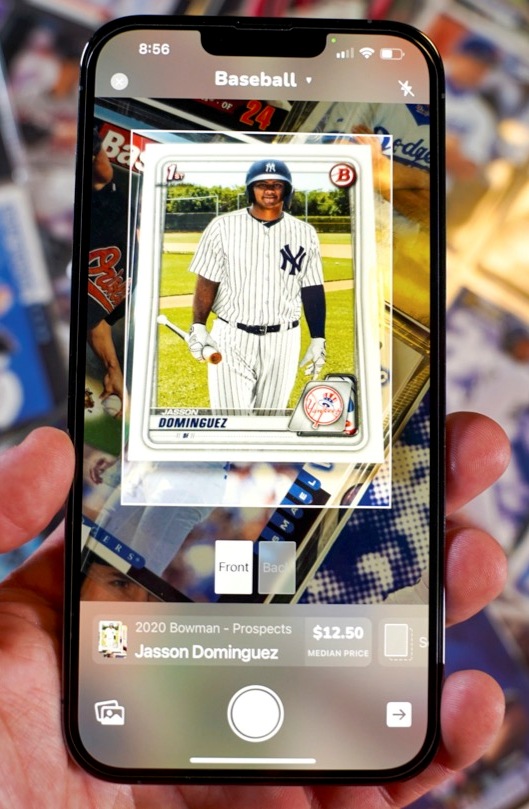
Yes, it looks like him, but let the image recognition decide.
Image Recognition – The Key to CollX
Ted Mann is an expert at how image recognition, a remarkable technology that CollX employs to determine what sports card it’s looking at. His son, of course, was aware of this when he suggested the idea of using it for sports cards.
“What we’re doing with CollX is a specific breed of image recognition that is sometimes called reverse image search, or reference image matching, where we have an existing reference image of a card. We’re trying to match the picture of the card that somebody’s taken on their smartphone to an image in our database.
“Think about it almost like matching fingerprints…when you’re matching a fingerprint, you don’t necessarily need to match everything about the fingerprint. You’re looking for the little variations that kind of define it. We kind of do the same thing. We have a deep learning model that is trained to identify specific features within each card image, and then we’re just trying to match up one to one.
“Imagine if the trading card itself was a QR code. And you’re basically just identifying that and matching that to an existing one in the database to get that one to one match.”
The explanation of the technology obviously goes much deeper, but Ted’s happy to take care of that for you so you and your son can scan your cards.

Be a part of the sportscard valuation community…
The Collector’s Community
Ted and Charlie and partner David Grzybowski recently attended a sportscard event in Atlantic City, where they were quite well received…and encouraged.
“I met probably a thousand people at the national in person who just really love the app. A couple of them came to me with a laundry list of features they’d love to see, which is great too.”
Incidentally, the audience for JerseyMan might find CollX right up their alley. “There’s a high overlap rate of entrepreneurs and card collecting,” Ted says. “It’s actually kind of a funny, it’s how a lot of them got started. I guess myself included.”
To Mann, the enthusiasm for CollX is an opportunity to improve things in the app, such as the accuracy of pricing, which has limits coming from auction sites where prices can vary.
“A lot of our data relies on eBay transactions and a lot of eBay transactions are bogus, we’ve learned. So when those happen, just helping us kind of prune those out. We’re actually gonna have an app update pretty shortly that gives some of that functionality so that our users can help us with that.
“We’ve done our best to come up with ways to average the prices or estimate the prices if needed. But the truth is we need help and we have 232,000 users, many of whom don’t mind putting in a little bit of extra effort to help us.”
Entrepreneurs who listen should be valued. CollX’s customer service is already an improvement over both of the TV providers in my area.

The Magic of Mio

I was given the privilege of interviewing Mio Rodriguez, a magician and mentalist of very high caliber in the Miami area, for the relatively new MiamiMan Magazine. You can view the magazine on MiamiMan’s website here, or have a look at the PDF of the article here.
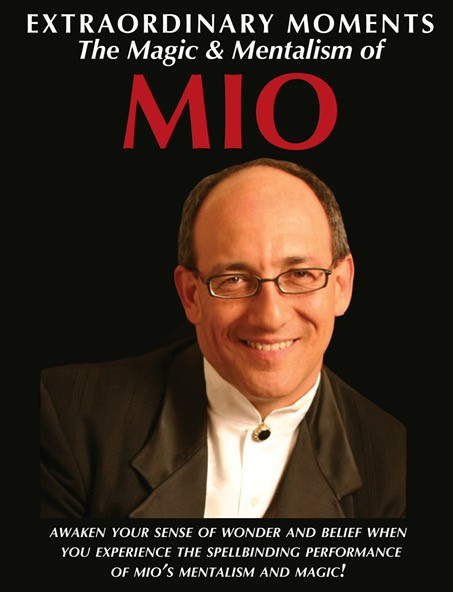
The Magic of Mio
Magic By Mio is a close-up magic and mentalism act that is mind-boggling enough to spread the word…even among some of the biggest stars in the world.
Mio Rodriguez is surprisingly polite while he makes your head explode.
Throughout our discussion, he repeatedly called this simple scribe “sir”, and thanked me for the interview in a truly sincere tone. He even threw in a brief performance free of charge.
Mio is unfailingly gracious and genuine…which, when you think about it, is an odd quality for someone whose career is about deception.
It’s a key component of not just his considerable lifelong success, but also being repeatedly invited to entertain some of the most well-known humans on Planet Earth.
Just for the record though, he’s really, really good at magic and mentalism too.
During the interview, he divined a digit I had mentally chosen from an eight-digit number on my phone’s calculator, and followed up by intuiting what I had just searched for on Wikipedia, guiding me with skilled patter.
It’s all tricks of course, but I was duly impressed…and couldn’t wait to play the recording for my children.
I’m not the only one.
Mio performs astounding card magic and confounding mind-reading tricks, both at an exceptionally high level. His goal is always to bring out the wonder we had as kids.
“I’ll do close-up magic, cards and coins in the cocktail hour, followed by a mentalism show after dinner. People come to me and say, ‘You know, the magic with cards was amazing. We didn’t see any sleight of hand, we just figured that’s how you did it.
“’But the mentalism…were you really reading our minds?’
“Mentalism is the new magic for adults,” Mio says. “They think they know how the card trick was done, but when it comes to mentalism, there’s still that childlike wonder…‘How the heck did he know what we’re thinking?’

Baffling Dan Marino can help land a mentalist some prime gigs.
(photo courtesy of Mio Rodriguez)
Mio’s Magic and Mentalism Show is well known today…not just in Miami, but in the highly exclusive celebrity world.
The list of names Mio has dazzled includes not just Miami’s own Dan Marino, Shaquille O’Neal, Wayne Huizenga, and Don Shula. You can view many more on his website…Stallone, DeNiro, Jordan, Gretzky, and countless others.
It started with Marino, though. Or more correctly Mrs. Marino.
“His wife saw me at someone’s party,” Mio remembers about a fateful moment, “and she has me at a birthday party for Dan at the Signature Grand.
“He liked what I did, and he said, ‘I want you to come to my celebrity golf tournament.’”
At that tournament, Mio says, “I met Mario Lemieux, he said, ‘Wow, I love your stuff. Can you do my celebrity golf tournament in Pittsburgh?’ One of his guests was Michael Jordan.”
And so on.
Mio has plenty of amusing stories about entertaining celebrities. He remembers a Christmas gathering with Pat Riley’s Heat:
“Riley had seen me at a party, and he wants me to come to the Heat’s Christmas party. He liked it so much he hired me for 12 parties in a row.
“For the last four years I did the party, LeBron was there. The first three years, other players would bring me over: ‘LeBron, you gotta see this!’ He would be like, I don’t like magic, I don’t wanna watch. The fourth year, finally he goes, okay, let’s see what you got.
“I do my favorite effect, a signed card to a wallet. When I bring his signed card out of the sealed envelope, he was like, ‘oh my God, that’s too much.’
“I go, let’s do one more. I have an invisible deck in my hand. I throw it to him and say, take a card out invisibly, turn it upside down, and throw it back. He throws the invisible deck, when I catch it, there’s a deck in my hand. I go, ‘I caught a pass from LeBron James! Sir, what card did you put in upside down?’
“At this point, Pat Riley’s come over. LeBron says the king of spades. I spread open the deck and there’s a card upside down. When I turn it over, it’s the king of spades.
“And Pat Riley goes, ‘You got the King with the King!’”
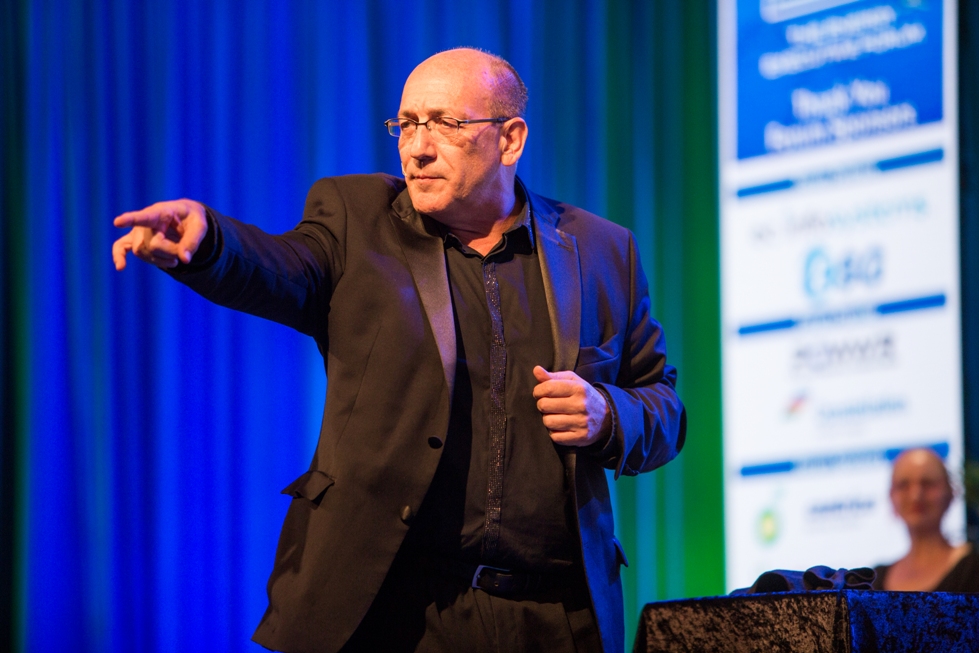
It takes years to develop this level of cool.
(photo courtesy of Mio Rodriguez)
It’s a fallacy that anyone is born to do anything, especially in entertainment. It discounts the deliberate intention to excel at a craft, and the persistence to convince others that your skills are worth a look.
Mio’s had life experiences pointing him to a career in magic, including coming from a show business family and performing in front of Mrs. Dan Marino. But he’s worked at it plenty, and he’s made his own breaks.
“My father was a professional costume designer and my mother was a dancer. In fact they met doing a show together. My father’s great love was magic, and although he wasn’t a professional, he was a very good magician. He would sit me on his lap and teach me magic with cards. When we would go to magic shows, he would tell me how things were being done.
“I just thought everybody’s dad knew, I didn’t know I was getting privileged information! I knew a few great card tricks, fun at a party or whatever, but I never thought of it as a career.”
But then one of those fateful nudges happened.
“A magician just happened to move in next door, who made a living at close-up magic. I’m like, ‘Wow, you can make a living?’
“He showed me an effect, and it turned out to be one my dad had taught me. I grabbed the deck and showed him my version, and he showed me his other version. Because I had some knowledge, he started sharing with me like I was a magician. He said, if you learn these seven basic moves of sleight of hand, you could be a magician.
“I studied and practiced, hours and hours a day for months and months. After about a year, I decided I was gonna try to make the transition and be a magician. I moved from Dallas to Florida in 1990.
“My friend was doing magic in restaurants; restaurant jobs are the basic fundamental stepping stone, the bottom rung of the ladder. I would come in Wednesday, Friday and Saturday, and go from table to table for a small salary and tips.
“Once I got those first jobs, I built off of those, then I started calling entertainment agents. I said, listen, I work at this restaurant, come in and have dinner, watch what I do and see if you like me. If you do, you can hire me for your private and corporate parties.”
A performer never knows when momentum is going to kick in. But years of hard work and making connections finally turned into “overnight success”.
“I gave my cards out for the first four or five years. Then one day I got a phone call: ‘I had your card for three years, we have a party.’ Then the next day I got a call, and then the next thing I knew I’m getting calls three, four, five times a week. All of a sudden business just exploded.”
“I’ve been working full-time for 32 years now. We’ve had a really great year here this year. People are coming back out of Covid, and it’s been some record numbers.”
Not bad for someone who started with a few card tricks at parties.

Entertainment that is welcome anywhere.
(photo courtesy of Mio Rodriguez)
As much as he enjoys the travel and performance life, Mio is planted in South Florida. It is, he says, a great place for a magician to call home.
“There’s a lot of corporations, conferences, and also parties, bar mitzvahs, all kinds of events. People come here and want to do something fun. Florida has a lot of people that have the ability and desire to have these parties, and they want great entertainment.
“I love Florida, the sporting activities, the fishing and the water activities. Even though it’s hot in the summer, the weather is overall fantastic. You’re not locked in. There’s so many opportunities here. It’s just a fun place to live.”
It’s an admirable lifestyle Mio’s carved out in the Magic City. He does quite well performing at corporate events, celebrity parties, and on cruise ships. His well-honed act sends him across the country…including Las Vegas, where magicians can be easily hired without travel expenses.
His lovely assistant…his wife Rhonda…performs a much more important function for Magic By Mio, Inc. than getting sawed in half. She handles Mio’s promotion, marketing, contracts, and the rest of the business end, so Mio can focus on staying on top of his game.
“It’s helped bring our business up,” Mio gratefully acknowledges. “She sends out all these email blasts and marketing that remind people of us, and they call us back, it just makes everything much more professional to have her.
“One job leads to another, because word of mouth is my strongest method of promotion. I don’t advertise. With the website there’s SEO, that’s the only thing I pay for.
“Things are newer, but back in the day, it was all word of mouth. And it still is.”
Those who have witnessed The Magic of Mio would agree. Just ask Pat Riley.
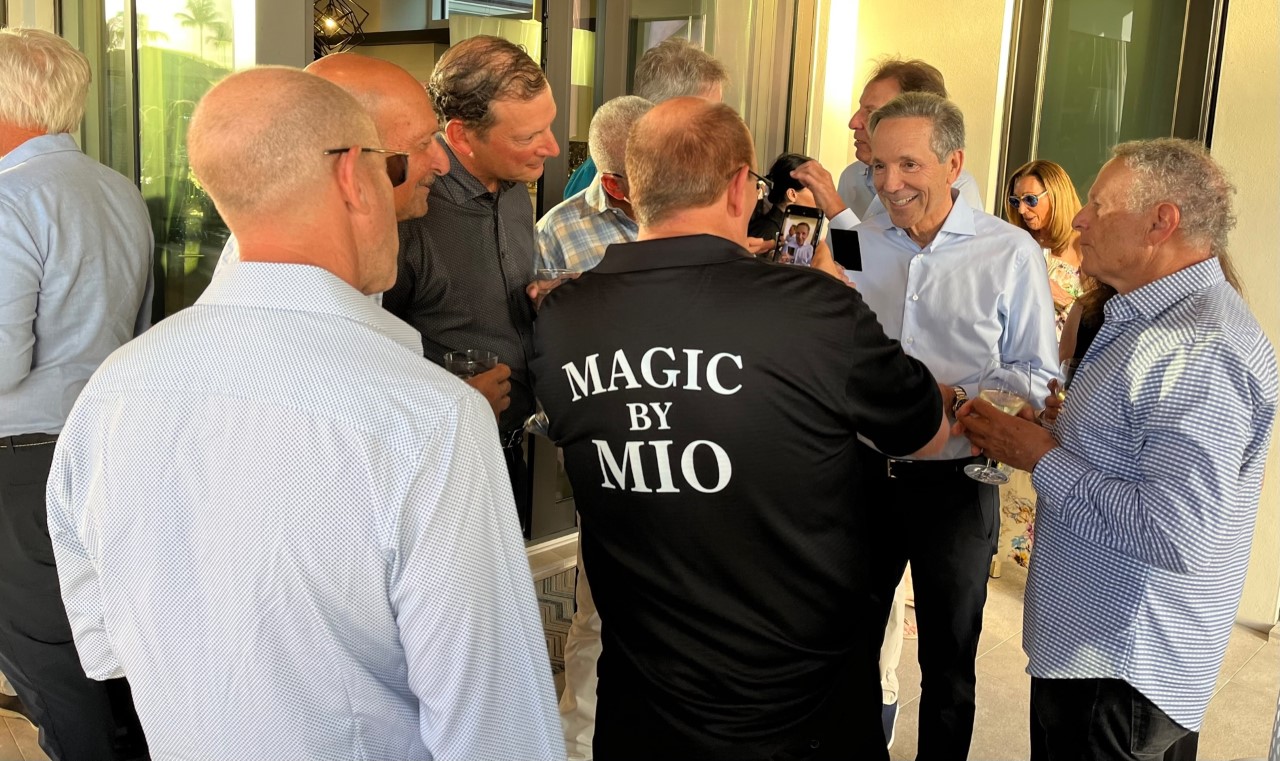
Magic that draws a crowd at your event.
(photo courtesy of Mio Rodriguez)
If You’re Interested…
MiamiMan probably doesn’t need to point out that if Mio is good enough to work the Heat’s Christmas party for over a decade, that his skills are exceptional enough to perform at a corporate event.
But he’s very easy to get a hold of, in case you’re interested…there is a contact form on his website, and his direct cell phone number is prominently displayed online as well.
You should probably contact him well ahead of time, though. Mio estimates that he performs about 145 shows a year, and many of those gigs put him on flights. The list of cities where he performs include Chicago, New York, Los Angeles, San Francisco, Washington, and many others, and his list of corporate clients includes IBM, Citibank, AT&T, UPS, Walgreen’s and many, many more.
You get it; Mio is in high demand…for his skills obviously, but also for his professionalism.
“For corporate, you want a really top rate entertainer who’s sophisticated. There’s a lot of CEOs, high level people, they’re spending a lot of money, and they don’t want anything hokey. They want to make sure they have a sophisticated entertainer who’s on a higher level, because they’re often wanting to impress other people.
“That’s what they get from me, and that’s one of the reasons I’m busy with so many corporate events, because once they find that out, the word also travels as well.
“I’m able to take care of their clients a professional, sophisticated, classy way, and that’s what they look for.”

Deal or no deal?
(photo courtesy of Mio Rodriguez)
As (Almost) Seen On TV
Mio Rodriguez just missed…twice…on capturing nationwide audiences on a level where he could add a “notoriety fee” to his performance price. He auditioned for both America’s Got Talent and Penn & Teller’s Fool Us shows, and just missed making it to the show both times…for reasons that had nothing to do with any lack of ability or skill.
“On America’s Got Talent, they called me up and wanted me to come on the show. I was doing mentalism in the audition, and they told me, ‘You don’t even have to wait in line. We want you to come audition for us.’
“We rehearsed in the morning, and I had two or three mentalism effects that were ready to go, but the producer or the director at the time had never heard of mentalism, and he kept skipping me. They just didn’t really understand what mentalism was. Now, of course they do, they’ve had mentalists get to the finals.
“What they actually ended up doing was choosing another magician who wasn’t very good. He was triple-X’ed off. I guess they needed, I don’t know, some humor on the show. It really upset me to the point where I didn’t try to get back on it.
His exclusion from Penn & Teller’s Fool Us is even more inexplicable.
“Penn & Teller, before they had their show, they were at one of those conventions in Vegas, and they saw me do some moves with the cards. They said, man, that’s the best we’ve ever seen. We want to film you, because we’re doing a documentary about the convention.
“They never did do that show, but in the meantime, I auditioned for Fool Us. They said, here’s the date of filming, make sure your calendar is open.
“But in the end, they never called me back.”
It’s unfortunate that America hasn’t had a chance to see Mio’s act on television. Mio has had audience members tell him that he’s as good as David Blaine. And more personable.

“Wait, what?”
Women in Magic (Yes, They Exist!)
Have you ever given any thought to why you have seen so few female magicians? In fact, you may not have even given it thought…in terms of magic performance, you might simply be accustomed to women in sexy clothing, climbing into a box to get sawed in half.
There is a post on Mio’s website about this phenomenon and how magic is one of the rare fields that has not yet been fully infiltrated by the fairer sex. In it, he references the iconic “We’ve got a witch!” scene from Monty Python & The Holy Grail. As humorous as the scene is, Mio says, “its implications are quite horrifying.”
“Throughout history, up until the 18th century in fact, accusing women of practicing witchcraft and heretical sorcery was often a near-instant death sentence.”
In modern times, Mio notes that “many parents and relatives make assumptions about the interests children will take up based on gender. Men are encouraged to pursue fields like sports and sciences based on gifts like athletic equipment, chemistry sets and magic sets. Women, less so.”
But Mio says this is changing, and points out an inspiring success story in particular.
“I have a good friend who is a magician, and he gave his niece a magic book when she was 13. She loved it, she started learning magic, and she declared at a young age, I’m gonna have a show in Vegas when I grow up, I’m gonna be a woman magician who has a show in Vegas. Lo and behold, she just celebrated her 500th show last week.
“Her name is Jen Kramer, and she’s one of the few women magicians right now that have a big show in Las Vegas. She basically created that for herself, she manifested that by saying, yes, I’m gonna be a magician, I’m gonna have my own room in Las Vegas.”
“That’s the kind of orientation, goal setting and tenacity that it takes for a woman, let alone a man, to do that.”
You can learn more about Jen Kramer at her website.
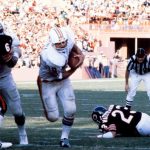
Larry Csonka – Zonk

For the debut issue of MiamiMan Magazine in April of 2022, the editors let me cover Super Bowl MVP Larry Csonka, the legendary fullback and key piece of the back-to-back Super Bowl Champion Dolphins. Zonk was very nice to me and had some great stories to share. You can see the PDF of the magazine article here, or see the article on MiamiMan’s website.

Even his eyebrows looked tough.
(photo courtesy of the Miami Dolphins)
Zonk
He was a legendary fullback and one of the most important players on a Miami Dolphins team that stood on top of the football world two years in a row. To this day, the Perfect 1972 team still stands alone.
To this day, Miami is the only NFL city whose team has gone a full season with a zero in the loss or tie columns.
Somewhere, probably in the clouds today, is an Akron area juvenile court judge and junior high principal we should thank for pointing a tough young kid in the right direction…back onto the football field, and on track to carry the ball for that perfect squad.
“I watched my older brother play,” Larry Csonka remembers. “and I went to a high school football game on a Friday night. There was probably three or four thousand people there, which was an immense crowd, I’d never seen anything like that growing up, a country kid on a farm. To play under the lights, I thought that was big time!
“I was sent down to the bench by my father, he sent a dollar down to my brother because he made a great catch. I got to go down by the bench and hand him the dollar, and I just marveled at the sidelines, I was just in awe of the whole thing. I couldn’t wait to get old enough to play.”
That is, until he was actually getting hit. “I went out for football in seventh grade, didn’t know anything about it, got knocked down a lot, and quit.”
Shortly after quitting, the kid from Stow, Ohio got into a bit of trouble, and was put before a forward-thinking judge who possibly saw his potential as a superstar fullback.
“The juvenile court judge told me that I needed to report to my principal every day. He would be responsible for me. Mr. Saltis made me write reports on football”, Csonka says with a laugh. “I started to understand the game and got back into it, otherwise I might not have ever played again.”
Every superstar player in sports history probably has a story of when their path to stardom came close to being derailed. Larry Csonka knows full well how important all of the ingredients are not just to an individual’s success, but to a team’s success.
We’ll come back to that.

The Dolphins were always happy to give Zonk the ball.
(photo courtesy of the Miami Dolphins)
In case you’re too young to remember Larry Csonka, or you need a refresher on what your parents told you, here’s a bit about why he was adored by the football loving faithful here.
In just eight seasons as a Dolphin, he rushed for 6,737 yards and 53 touchdowns…both still team records to this day. He averaged over five yards a carry in 1971 and 1972, and in 1979, as a power running back at the age of 32, he rushed for 837 yards and 12 touchdowns.
He also was, obviously, a key player on the unbeatable 1972 team, gaining 1,117 yards and averaging 5.2 yards a carry. The following season he was a Super Bowl MVP, rushing for 145 yards and two touchdowns against the Vikings. Read that again…Zonk ran for 145 yards against a defense good enough to be in the Super Bowl.
A player known for his legendary toughness, and sometimes carrying several defenders with him into the end zone, is quick to credit another man for his drive on the field…another legend in Miami, otherwise known as the winningest coach in football history.
“The competitiveness of it grew on me a little later, and then meeting a guy named Don Shula in the pros rejuvenated that feeling I had when I was a boy. After going through junior high, high school, college and being on some winning teams, I was motivated by that, but I still hadn’t become possessed by it. When you play for Shula, you either become possessed or you play for another team.
Csonka tells a story about Shula’s motivational skills that isn’t surprising.
“I got hit one time and was laying on the sidelines, and he ran up to me and said, ‘You can’t be hurt!’ It made me so mad I forgot I was hurt, I jumped up to grab him, and he took off!” Csonka remembers with a laugh. “He said, ‘I knew if I made you mad enough you’d forget you were hurt!’”
“He had a real chip on his shoulder about being unprepared, he wanted to anticipate everything that could be anticipated. In other words, total concentration, total commitment to the win.
“Now, that sounds easy, and all of us want to do it, and that sounds fine to go to a Boy Scout meeting and stand out and get your honorary badge, that’s great. But when you do it 17 or 18 times in a row, it’s hard to keep that up. And he would mandate that, he would demand that, and he would raise hell if he thought you were screwing around in practice and not paying attention.
“Two and a half hours, a couple of times a day – that’s five hours a day, and you’re talking about six weeks of intense concentration in training camp. It’s pretty hard to keep that up, on that plane, but with him behind you, we were motivated to stay on that plane.”
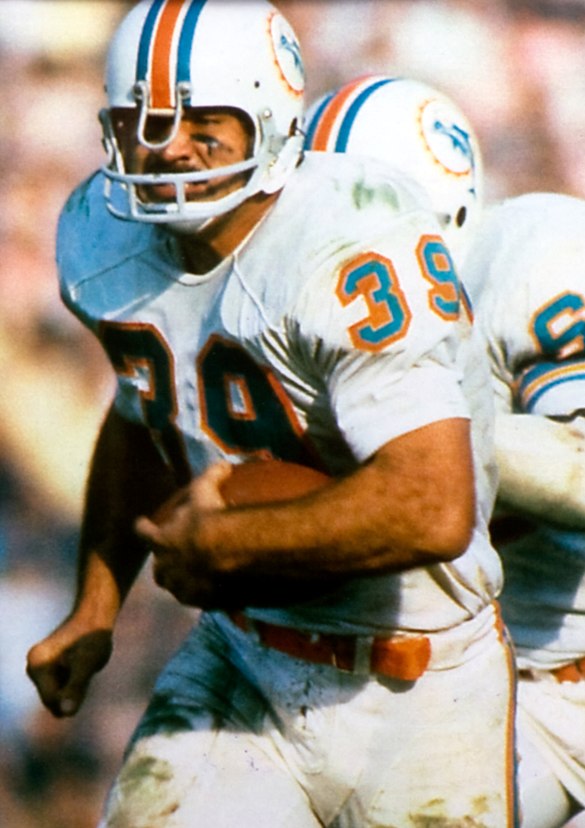
Beat him in the Super Bowl? OK, now he’s mad.
(photo courtesy of the Miami Dolphins)
Zonk remembers that Don Shula pushed for absolutely every edge on a football field…including having a team train in the July Miami heat to prepare for hot days. After an embarrassing Super Bowl loss to the Cowboys, the coach made the team use the loss as motivation.
It worked out literally perfectly.
“Getting that far in ’71, and then getting your ass handed to you in the Super Bowl was embarrassing. But Shula said to us after that game, ‘I want you to remember this moment, because we’re gonna use this as a basis to make even more sacrifices next year.’
“He didn’t say what our objective was going to be. What he said was, we’re gonna treat every game like it’s the Super Bowl. That way we can’t ever relax. By the time we get to the Super Bowl, we’ll be able to make sure that we do it one more time.
“Those words rang true, that was a great prediction after a terrible loss.”
Indeed, as the football world remembers, the Miami Dolphins made winning quite the habit in 1972. The backfield of that team contributed to the obsession…the interchangeable squad of Csonka, Jim Kiick, and Mercury Morris made opposing defensive coordinators want to put 15 players on the field. It was an idea Shula had once he believed Morris could take the punishment.
“Coach Shula decided to talk with the offensive line coach to see if we had the offensive linemen that could get to the outside. And we did. Larry Little, a huge big man, who was super fast in the 40, so we could get somebody out there to block for Merc, and we could have that outside threat.”
“It gave us a three-dimensional backfield, and that made a difference. That was one of the contributing factors to going undefeated.”
The Dolphins’ backfield was so strong that even losing a Hall of Fame quarterback in the fifth game didn’t stop the victory train. But Csonka is quick to point out that absolutely everyone on the team made contributions to a season still unmatched in NFL history…starting with Kiick and Morris.
“In order to do that,” Csonka reflects about the interchangeable backfield, “you have to have the talent to do that, but you also have to have the personalities to do that. Jim Kiick and Mercury Morris were two unique personalities, but the great common thing between them was the mutual respect of each other, one realized the other had talent that he didn’t, and they both recognized that fact, and were all right with that.
He continues: “If any one ingredient doesn’t mix with the other ingredients, then you’re gonna have that kind of animosity that’ll grow to be a cancer and it’ll keep you from attaining a perfect season. There’s a reason there’s only one team that’s ever done that. We had the best blend of players and coaches.”
“When you look at it, you take any one player, if you take Bob Griese, starting quarterback, Earl Morrall, the substitute quarterback, all made contributions. Charlie Babb, special teams, rookie player, got in there, made a big play, blocked a punt. You take Charlie out of that game, we lose that game.
“As a rookie playing on special teams, only got on the field a few times, but he got on there just enough to make a difference in us going undefeated or losing one game.
“That’s how finite it gets.”

Profile of a Hall of Famer.
(photo courtesy of Audrey Bradshaw)
Zonk is, at least partially, so fondly remembered in South Florida for an unfortunate reason. He represents a successful era for a team that hasn’t won a playoff game in over two decades. Young Miami football fans aren’t even accustomed to frequent playoff runs these days, much less three straight Super Bowl appearances.
Read some of the blog posts on his website about the team in recent years, and it’s apparent that like the rest of the city, he becomes frustrated with the Dolphins’ shortcomings. He’s still supportive, but it’s clear that it’s no easier for him to watch sometimes than for the rest of us.
Csonka confesses to not being able to apply his understanding of the game in his playing days to the game of today. But he does think there’s one constant in winning football that the Dolphins need to embrace to get back on top again. When asked that question, he begins his answer with one word: unity.
“If you get a strong head coach that believes in a certain way to do it, and you can get a cast of players that believe in him, I don’t think that formula’s changed that much.
“Is it Don Shula reborn again? I don’t know, but I think it starts with that. I think it starts with a strong coaching staff and the dedication of the players, and finding 40 or 50 players that really, truly want to win, and they’ll make whatever sacrifices that are necessary in order to obtain that.”
That said, he does make occasional public appearance to talk about the glory days.
“We get a few fans, that might go back and remember, and some of the young folks that have heard things from their parents or grandparents, or perhaps even great grandparents,” he says with a laugh. “What I do is reminisce about the championships and how we got there, Coach Shula, the colorful, fun parts of the game that you still see on Sunday are fun to talk about. Sports humor is really what it’s about, it’s a good time, not any deep message or anything.”
The Perfect Season, justifiably, is still today a great source of gratification for the Hall of Fame fullback.
“More than personal pride, it’s fun to feel a team pride in being part of that. I’m sure there are other people that have made it to the top of Everest and stood there and felt that exhilaration of being on top of the mountain. But to be able to stand on top of the mountain, and know there’s an entire team standing there with you and you’re all part of that, is just another benefit.
“When the ’72 team gets together, those that are still standing and walking around, there’s a great camaraderie, and there’s a constant feeling when eyes meet, nothing has to be said.
“The fans that were there, again, that are still standing, when we see them, it’s a celebration that’s very unique. They can’t wait to tell us about it, we can’t wait to hear about it. It’s a celebration that goes on and it’s just as enthusiastic today as the day it happened.”
Zonk also has a sense of gratitude towards one other group of people: The Super Bowl XLII-winning New York Giants.
“I’m indebted to my teammate at Syracuse, Tom Coughlin, the head coach of the Giants, and Eli Manning. I am still their biggest fan!”
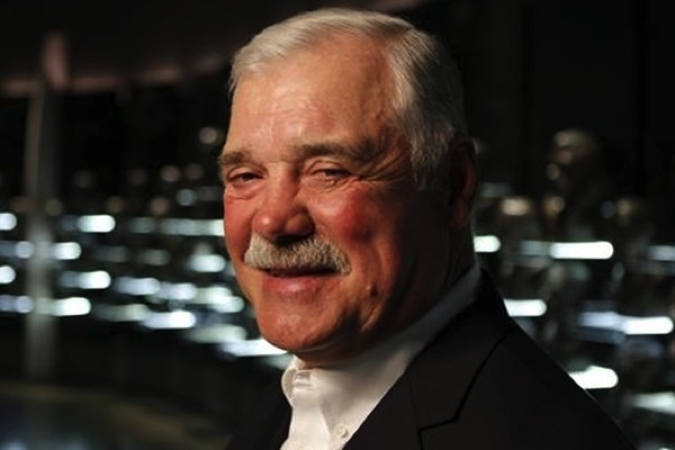
And an author as well.
(photo courtesy of Audrey Bradshaw)
Head On
MiamiMan loves success stories and views behind the scenes, especially when it comes to legendary sports achievements…and the Perfect Season certainly qualifies.
Larry Csonka’s coming book, Head On, shares tales behind his and the Dolphins success in that era. It includes flashbacks of his nearly quitting football, his occasionally rocky relationship with Don Shula, and his palling around with the likes of Burt Reynolds, Lee Majors, Elvis Presley and others during and after the Dolphins’ high-flying run.
But Csonka also shares some wild stories beyond the bright lights of the football field…such as his confronting thieves with a sawed-off shotgun, being adrift in gale force winds in the Bering Sea, and taking sniper fire in the midst of a USO tour.
As Csonka was quoted in Life magazine back in 1972, “No matter what your style, you have to take a beating.” Indeed, from the sound of it, the book describes a life of an athlete who took the hits on and off the field, and keeps moving forward.
Head On is slated for release on October 4, 2022. You can pre-order it on the Amazon and Barnes & Noble websites, and from the publisher, BenBella Books.
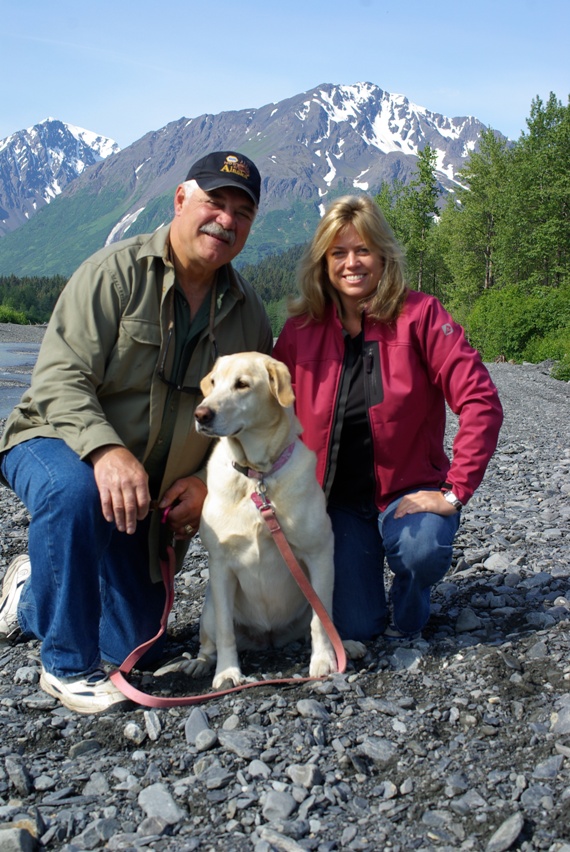
Larry and Audrey living the way Davy Crockett did.
(photo courtesy of Audrey Bradshaw)
The Last Frontier
Visit Larry Csonka’s website and you’ll see a selection of videos of him and Audrey Bradshaw, his lovely longtime partner, catching fish in the midst of beautiful Alaskan backgrounds.
Many of the videos are from his surprise hit show, “North To Alaska”, which enjoyed a successful run until its retirement in 2013. ”North To Alaska” was everything an outdoor life show should be…a former star athlete enjoying retirement by becoming just like one of the rest of us again. He and Audrey catch fish together, visit beautiful lodges in remote areas of a remote state, and share the greatness of outdoor life in the last frontier. It all makes for enjoyable, leisurely, and educational television.
What makes “North To Alaska” special enough to have enjoyed a 16-year run is that Zonk, a man who made a considerable mark on a football field, is there as a hunting and fishing enthusiast, not a former star athlete. It’s because he has just as much enthusiasm for Alaskan life as he did for football.
“Through my entire career, starting in high school or junior high, I aspired to get to Alaska by hook or crook. I got sidetracked into the NFL, and some ten years after the NFL, I finally got a chance. Starting with ESPN and our sponsors NAPA and STIHL, we put together an outdoor adventure, fishing, hunting series. Audrey and I moved north and bought a place in Anchorage and then Wasilla. We were residents of Alaska for some 20 years, and still go back for a month and a half each year.
“I think from the time I was probably 11 years old, I just wanted to go to Alaska because I figured that was the last place you could experience things like Daniel Boone and Davy Crockett did.
“What a great way to do it, getting paid to do it. By the time the series ended, it was doing quite well. By the time it was in its 16th year, we had been a lot of places that most people don’t get to see in the state of Alaska.”
The popularity of a retired football star, even a Hall of Famer and Super Bowl MVP, isn’t enough to carry a low-quality show for a decade and a half. The appeal of “North To Alaska” may be that Zonk shows us all that it doesn’t take piles of money or fame to enjoy the good life. He’s the ultimate everyman with a genuine love for the outdoors, and it works.

A lot of nuns didn’t think it was funny at the time.
A Bird On The Cover
Larry Csonka made the cover of Sports Illustrated a few times in his career, but easily the best known cover shot features him and backfield teammate Jim Kiick…in a pose that featured Csonka giving a not-so-subtle middle finger. What makes the photo so priceless is the snickering look on Zonk’s face. You can easily find a copy of it on eBay if you’re interested.
Intentional? Not on Csonka’s part, at least as far as the photo actually making the cover. He’s not sure about the Sports Illustrated folks, though.
“We shot probably 200 photos that day of all the different kinds of poses. We had a couple of photos we just wanted for us to be funny, so we did that, and somehow that photo got in with the others and somehow inadvertently got put on the cover. I received very nasty letters from irate nuns for about five years after that!
“I sometimes wonder if that wasn’t done on purpose, but it wasn’t meant to be on the cover, it was meant for our own personal thing. So after that, I didn’t do that anymore. I certainly apologized, but at the same time, it was supposed to be private and it didn’t turn out that way.”
“But I’ll tell you what, a lot of people kept that issue!”
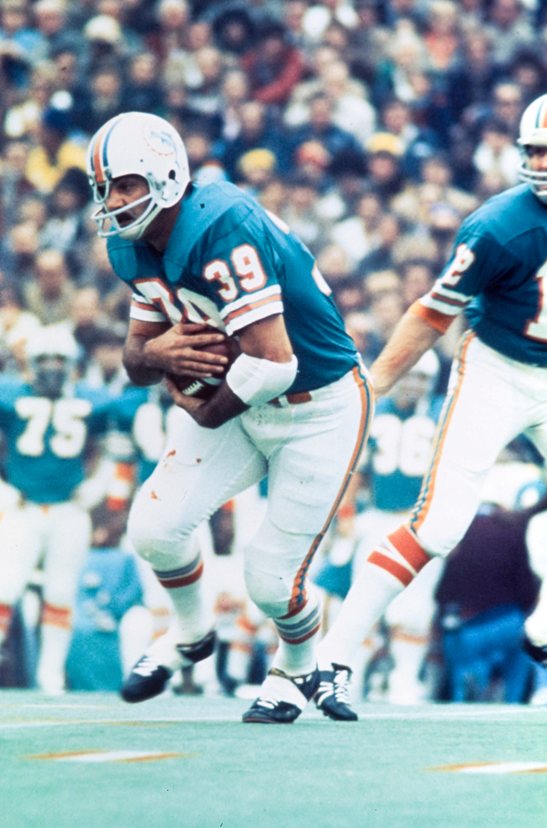
And a comeback player, too.
(photo courtesy of the Miami Dolphins)
Going Out On Top
Csonka broke away from the NFL to play in the ill-fated World Football League with the Memphis Southmen, and then played a couple of seasons with the Giants before returning to play with the Dolphins in 1979. He was hired by the Dolphins to be a blocking back for Delvin Williams, but when Delvin performed below expectations, they gave Zonk the ball…and he carried it for 837 yards and 12 touchdowns, a performance that won Zonk the Comeback Player of The Year award.
“I came back to be a blocking back for Miami. I became the guy running the ball. I think on one occasion, I carried it 40 times in a game, and at 32 years old, whatever I was at the time, I don’t recall, I didn’t need to be carrying the ball 40 times a game.
“That’s very much a young man’s game, a power running game, and you have to have great offensive linemen, which I had in ’72 and ’73.
The end of Larry Csonka’s NFL career came shortly afterward, with Don Shula making the decision for him.
“I made the decision to hold out, unless I got paid a whole lot of money to run the ball, I was still pretty healthy. But instead, I held out and Shula got mad and fired me.”
He has no regrets. “I wasn’t mad that he fired me. I was at a point in my career where I was glad he said I was through. That gave me all the pushing I needed.
“At 33 years old, it’s time to retire, particularly for a power running back.”

Steve Friedman – Champions of Cheltenham
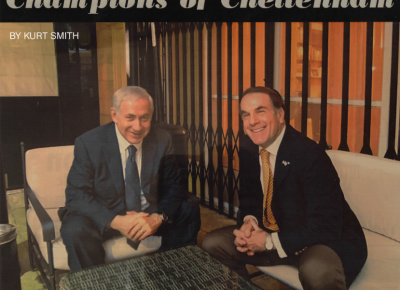
For the Winter 2021 issue, JerseyMan sent me to interview Steve Friedman, a Philadelphia attorney for the Duane Morris Firm (he is since no longer with the firm). Steve is close friends with Israel Prime Minister Benjamin Netanyahu, and he told me a few stories about Bibi and his character. You can read this on the JerseyMan site here, or read the PDF from the magazine here.
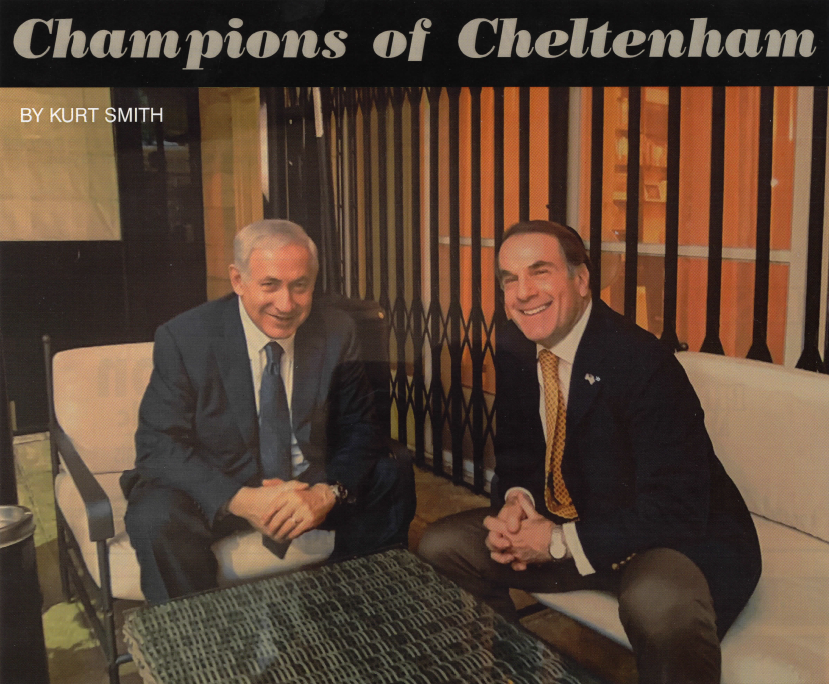
Champions of Cheltenham – Steve Friedman
Steve Friedman is a longtime success story as a Philadelphia attorney for the Duane Morris firm. He’s also a close personal friend of the Israeli Prime Minister and fellow Cheltenham High alumni Benjamin Netanyahu. The two share a common ability: to make a difference through people skills.
On August 13, 2020, the U.A.E. acknowledged normalized relations with the state of Israel. It was momentous enough to interrupt wall-to-wall pandemic coverage.
It was also the type of event that foreign policy “experts” were claiming for decades wasn’t possible.
But Philadelphia attorney Steve Friedman knows Benjamin Netanyahu well enough to know that Bibi didn’t rise to the top of the Israeli government by listening to bureaucrats, who often manage to attain “expert” status without ever actually achieving anything.
The two have been friends since attending Cheltenham High together. Friedman understands Netanyahu’s gift for the big picture.
“One of the great skill sets and amazing record of achievement of Prime Minister Netanyahu is in international relationships, especially in Africa,” Friedman explains. “He developed a relationship with Egypt and with Jordan. But to get a relationship with the U.A.E., it’s mind-boggling. It’s just incredible.
“There was nobody in the world who said, ‘the greatest threat to the world is Iran.’ I heard that from him in 1982. Nobody was talking about that; they weren’t talking about it 20 years ago.
“He’s always understood that, and what really has driven this tremendous change in relationship between Israel and these countries…it’s essentially a mutual fear of Iran. They began to realize, Israel is not the enemy. Netanyahu is not the enemy. It’s Iran, the Ayatollahs, and their very radical views for the way life should be lived.”
Steve Friedman currently practices for the prestigious Duane Morris firm. On the company’s website, he’s listed as being a “personal and legal advisor” to Netanyahu, which he admits is a bit pretentious. He didn’t write that.
“Let’s put it this way,” he says, “We’re very close. We just talk and he’s a very smart guy, so he talks to anybody. I think he uses me because of my involvement in some things in the U.S. He’s always interested in knowing what’s going on here, and to an extent, I can help him with that.”
Friedman remembers walking with Bibi from the U.N. to the Israeli ambassador’s apartment on 85th Street. Which, incidentally, is quite a hike.
“There would be these secret service guys and state department security, and he would walk like Mr. Magoo. He ignored traffic lights, just kept walking, and I could see these guys thinking, ‘God, just don’t get killed on my watch!’”
So while Friedman does, in so many words, advise Netanyahu on U.S.-Israeli relations, that probably isn’t the key selling point for hiring him.
More likely, you’d call on him to protect your company’s trade secrets.
He’s had a bit of experience doing so with high profile clients, including NutriSystem during their high-flying 1990s run. A weight loss company that enabled people to eat pancakes and still lose weight inspired quite a few copycats, including Heinz and Jenny Craig.
“Heinz owned Weight Watchers,” Friedman recalls. “It’s been years, but my best recollection is it was triggered by a relatively high ranking employee, who left NutriSystem and went to Weight Watchers. The next thing you know, we see them starting to do things that seem very similar to the unique procedures that NutriSystem had.”
A similar situation occurred with Sid and Jenny Craig, a case where Friedman successfully negotiated a large settlement.
“They originally had a relationship with NutriSystem, they then went to California, and waited for their non-compete to expire. They started a company in Australia, and then they came back to California and expanded. It was called Jenny Craig, and they started using what we thought were trade secrets to NutriSystem.
“Shea & Gould, the New York law firm, was on the other side. Very good lawyer. We went at it and pounded each other for a while and then settled the case.
“These cases start because somebody works for Company A, begins to understand the trade secrets, has a binding agreement not to disclose them, or under common law or the law of the state where they’re living, can’t disclose them anyway. Then they go to Company B, and then Company B is starting to do things that Company A did.”
Friedman has enjoyed substantial success convincing juries over the years, enough to earn multiple speaking engagements. One is titled “Selling Your Case to the Jury: How to Effectively Communicate the Technology Behind the Patent Dispute”.
“You have a story to tell, and it’s a narrative, and you hopefully have most of the facts that support it, and you have to convince the jury that your narrative is true and demands relief. It’s the essence of any good trial lawyer.”
Friedman achieved an even greater milestone representing Signature Financial Group against State Street Bank in a Federal Circuit appeals court. It was technology-based litigation in the late 1990s, as the Internet was beginning to flourish. Friedman estimates that the case had an audience approaching 500 people.
“I practiced arguments in front of panels of patent lawyers, to really pepper me with questions, to prepare me. When I walked in that courtroom, I just said, ‘we’re gonna win this.’”
The preparation turned out to be secondary in the win.
“The Chief Judge was a very senior guy in his 90s, Giles Rich,” Friedman reflects. “He had drafted the patent amendments in 1952. The opening question from Rich was, ‘Mr. Friedman, I see you’re not a patent lawyer, I find it interesting that you’re here.’
“I went on and on with some answer, and I said, ‘I know that you published the amendments to the patent laws of 1952, so I’m honored to be in your company.’
“It was just total bulls***! And he was so taken that everybody on my side said, ‘Oh my God, he had a twinkle in his eye!’ They said, that’s when you won the case.
“There was nothing dishonest, it was actually true, I was trying to play to his ego a little bit. Then about eight months later, we got the opinion and we won.”
How powerful is a personal rapport with a judge? Judge Rich’s ruling in the case was considered not only controversial, but contradicting of his own past decisions. That’s how much Rich liked Friedman. Rich’s Wikipedia page describes it thus:
“Judge Rich justified his conclusion on the basis that the business method exception to patentability was abolished by the 1952 Patent Act. However, this line of reasoning is contradicted by Judge Rich himself, among others. He had earlier stated, in a law review article written not long after the passage of the Patent Act, that Section 101 of the Act denied patent protection to business methods, observing that the diaper service, ‘one of the greatest inventions of our times,’ was patent-ineligible because it was a business method.”
To simplify all of that, maybe flattery really does get you everywhere in a courtroom. Including out on the lecture circuit, where Friedman spent several years as a result of the ruling.
Friedman has too many personal and professional stories to fit into the 1,300 words JerseyMan gives writers.
He may not have Netanyahu’s track record for public relations. Not many humans do. But like his Prime Minister friend, Friedman understands the value of storytelling and people skills, and the difference it can make.
During this interview, he even invited this writer to visit the memorial for Netanyahu’s brother with him. Yonatan Netanyahu was killed in Operation Entebbe in 1976; Friedman and Benjamin dedicated the memorial in 1982.
“Being a good trial lawyer…or being a good lawyer, period…about 98% of it is people skills, the ability to deal with people, understand people, and get them to work with you. And that’s true of life in general.
“It’s the heart of politics, it’s the heart of business, it’s the heart of everything.”
Hope you’ve enjoyed this article about a long respected attorney…
If you did, I would really appreciate your support.
When you use this link to shop on Amazon, you’ll help subsidize this great website…at no extra charge to you.
Thanks very much…come back soon!
The Hits That Made Me A Lawyer
Remember, as comedian Gary Gulman says, how football coaches used to refer to players incurring concussions from nasty hits: “He got his bell rung”?
As a high school and college football player…who shared a backfield at Cheltenham High with none other than “Mr. October” Reggie Jackson…Steve Friedman had his bell rung a few times. It ultimately ended his football career, which he thinks was probably a good thing.
“I had one concussion in high school, as a sophomore, I must have got hit in the head. I got up and I started walking down the field. They grabbed me and put me on the bench. I’m fully conscious, but I have no idea who I am, and then as the game is still going, I started to figure it out. That was the first one, and then the other two were sophomore year. Football was my life from the age of four until about 20, and then I was done.”
He learned in his freshman year at Yale that football has a way of talking you out of playing it.
“When I was a freshman, we would scrimmage against the varsity. The senior fullback was Chuck Mercein. You run at each other pretty hard, and I had pumped up to about 208, 210, Mercein was about 235, and running into him was like running into the edge of a steel building.
“Three years later, when I was a junior, I watched him in the first two Super Bowls, as a running back for the Green Bay Packers, and said to myself, boy, was I over my head!
He has no regrets. “I was always very proud of it, and the good news is, I had the brain concussions, presumably I can still talk and walk. Some friends joke with you, they say Steve, you were really stupid until you got those brain concussions, and you got a lot better!”
Photo credit: miss_rogue on Best Running
Photo credit: PFX Photo on Best Running
Photo credit: Official U.S. Navy Imagery on Best Running

E-ZPass: Tae Seangpeoam Interview

Tae Seangpeoam is the owner of Neztec Solutions, helping businesses’ communications meet regulations in a rapidly growing global economy. His street cred? He was a senior network engineer on the team that made E-ZPass work. JerseyMan sent me to interview Seangpeoam about the story. You can read the article on their website here, or view the magazine article here.
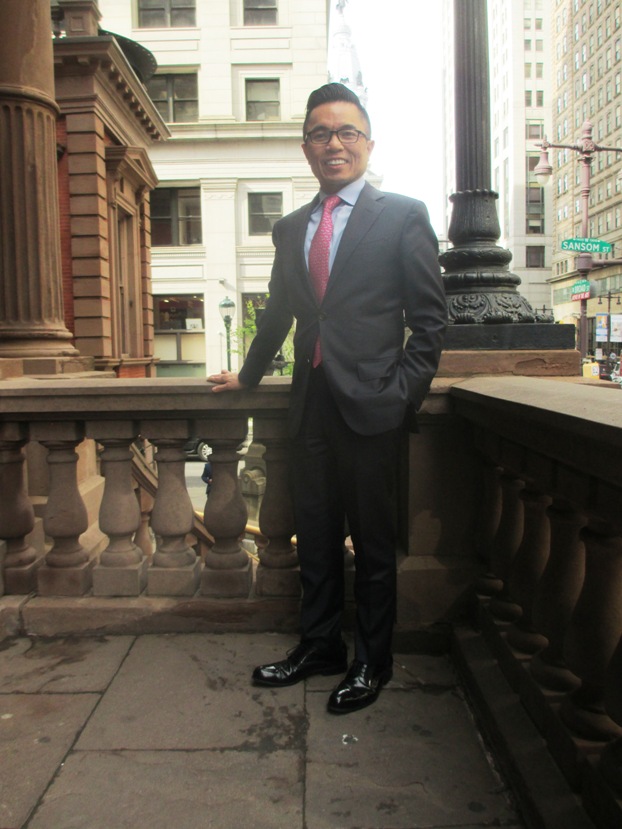
E-ZPass: Making Life EZ-er
When this writer’s young son first hears the “you kids don’t know how good you have it” speech from Dad, you can bet E-ZPass will be part of the conversation.
“Transponder? Heck, we didn’t even know what a ‘trans-pond-er’ was! Back in those days you dug into your pockets for that extra quarter ’cause the rates went up all the time, and you had to sit there waiting at the booth for hours, and then you had to hand your cash over to that guy who always dropped your change on the ground! Plus you had all those people asking directions while you’re waiting, like them toll takers are AAA or somethin’! You kids today ain’t got no idea what it’s like to be searching for a dime on the floor while you’re…look at me when I’m talking to you, son.”
Yes sir, those were the good old days.
Making the switch from stopping at booths and dropping exact change in baskets to using E-ZPass to fly through a toll plaza is one of those “why did I put up with that for so long” moments in life. That little white tablet stuck to your windshield opens up a whole new world.
Suddenly getting off of the Pennsylvania Turnpike temporarily for a break or a bite to eat is a more viable option, since you no longer have to dig out a few bucks and sit at a toll booth yet one more time. An empty pocket no longer stops you from using a toll road as an alternative to a jammed freeway. Tolls for E-ZPass users are less expensive in peak times, and now using the pay as you go road for the length of a long trip isn’t such an expensive idea.
Not to mention that little bit about how we don’t have to sit and wait at tollbooths anymore.
Tae Seangpeoam, founder of Neztec Solutions, is one of the people we can thank for the considerable road stress reduction from that little invention. Seangpeoam was a senior network engineer for MFS Technologies (bought out by MCI WorldCom that year) when the company was called on to improve a promising but fledgling electronic toll system.
As he sat on a sofa at the Philadelphia Union League where we conducted the interview, he clearly enjoyed the trip down a toll-free memory lane.
“I had just come out from college,” Seangpeoam remembers. “I was almost the youngest one on the team. I was so excited, they were saying it was going to be the project of a lifetime. When you’re young, to prove yourself, you do it. I was lucky.
“E-ZPass started in 1980, the idea. But it was never successful anywhere. There were many failures due to design, engineering, and government agencies. The project would never go anywhere because it kept collapsing between authorities. My responsibility, as a senior network engineer, was to design the architecture for the telecommunication; the communication between all of the toll booths going back to New York, to the violation process center, and to the customer service center.
“During that time the main problem was billing. Sometimes it would detect an axle, sometimes not, sometimes it wouldn’t detect your license plate. The camera was not clear, it couldn’t read clearly. The system didn’t know how to match that, and it would send a wrong bill or something. Back in those days, each toll booth didn’t have anything at all. It was just bare bones toll booths. Atlantic City Expressway, Garden State Parkway, they just had manual booths.
“We went in, took a look and surveyed everything, can feed a fiber optic line through that, or are we gonna do something else? We put satellites in several locations around Atlantic City. We did all that to link the communications back. All the transactions from the toll booth link back to the center to process, every transaction at the toll booth links back to the main frame. Also the security aspect…we had to make sure that the firewall and every single thing under the sensor is protected.”
“When we launched in Delaware, it was a tremendous success. All the toll booths were connecting to each other throughout New Jersey and Delaware, all the transactions were processed at the Violation Process Center and Customer Service Center, all the tags and transponder were communicating to the system, censor and lighting, backup video record, etc.
“The whole project was about three years; then I left the company and went to work for Verizon. I have a passion about communication; every single thing about it.”
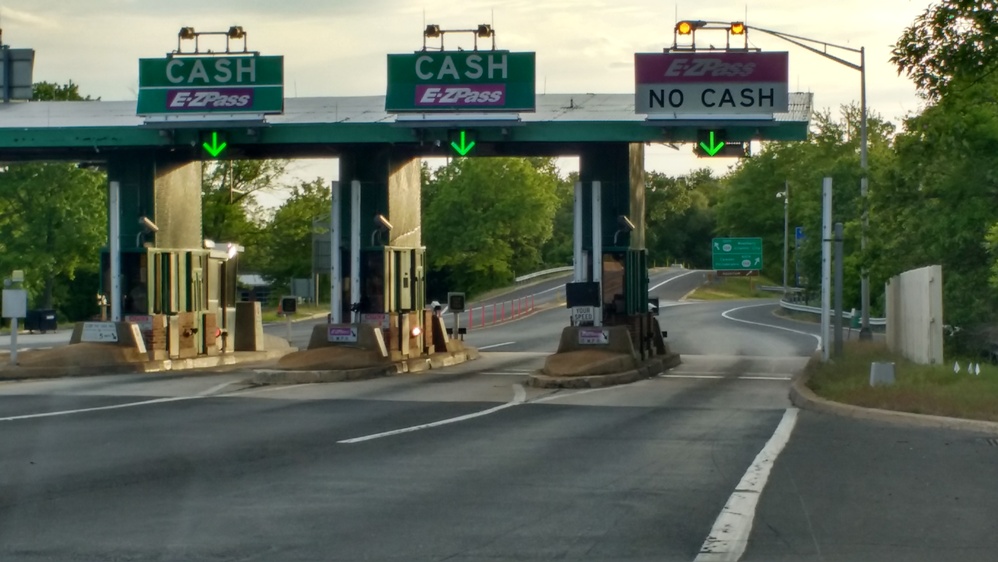
It works so well we’ll use it in every lane.
So when you sail through the E-ZPass express lane, is there a camera taking a picture of your car and sending it to E-ZPass Mission Control to fire off the bill in the mail? Well, yes, that’s sort of what happens. But there is, of course, more to it than that.
As Seangpeoam explains, the transponder on your car connects with a sensor at the toll booth, and it sends a signal that the car with your ID is approaching. As your car is passing through, E-ZPass completes an entire profile on it…the type of car, how many axles, who owns the transponder, etc. Seangpeoam says it all has to jibe, especially the number of axles.
“If you look down the road at the toll booth, you’ll see the sensor of the treadle, to tell if your vehicle is a two-wheel, four-wheel, sixteen-wheel and so on. Those need to match to whatever the camera sees. The tag sends the signal that the car is coming, that’s what goes through the transponder. But it also sends a signal to another interface behind the scenes, to make sure that matches your transaction, because otherwise it could be a motorcycle or whatever.
Does that mean you really shouldn’t be using your transponder in your wife’s car? “You can use it in your wife’s car, but legally that’s a violation.”
This writer hasn’t yet tried that with his own tag, but Seangpeoam assures me that this contingency had been considered by the network people. “You’ll get the bill,” he says.
Today Seangpeoam runs the show at Neztec Solutions. His services, according to his business card, include real-time messaging, visual communications, and safety/compliance.
“In the past 10-15 years, you’ve started to see the global economy growing,” he explains, “And every single business has to deal with rules and regulations and compliance. That becomes really complex, and it is getting more and more complex. Even the small business has to deal with certain types of compliance and regulation.
“No matter what you do, no matter how good the things you come up with, communication is always the bottom line of the process. You’ve got A, you’ve got B, how are they going to communicate?”
Has the E-ZPass experience, especially persuading state governments to cooperate with each other, given him street smarts? “Absolutely. I wouldn’t be where I am now without that knowledge.”
He’s still today pleased with the results of the system he helped design. As he should be. Imagine I-295 today on Thanksgiving weekend, he says, how backed up the toll booths would be, say, at the Delaware Memorial Bridge. No thanks.
“I am really proud in what I have contributed to my adopted country. I was lucky enough to be part of wonderful projects; it gave me foresight to build a career around my life, and see the future of transportation, roadways, bridges and tunnels, and infrastructure communications.”
“Less time, less energy, less frustration, people are happier, more productivity for sure. You get to your destination faster, and with less stress.
I’m proud of that because again, the purpose of communications is to take society to the next level. If you want to make a phone call right now, you push the number and it’s gonna ring on the other side. The devil is in the details no one sees, everything on the surface is very simple, very easy, but that’s why an engineer like me loves it. I love to go behind the scenes and see what makes things happen without people knowing it.
“I’m a technology guy. I love technology. However, I don’t believe in technology that comes out and makes people learn how to use it. E-ZPass is the only technology in the past 15, 20 years or whatever, do you need to learn how to use it? No. You just slap it on the windshield and go. Even kids know how to use it, because it doesn’t require you to learn anything.
“That’s what technology is supposed to do.”
Hope you enjoyed this article about E-ZPass and its impact…
If you did, I would really appreciate your support.
When you use this link to shop on Amazon, you’ll help subsidize this great website…at no extra charge to you.
Thanks very much…come back soon!

